#all the ones I listed aired in mexico dubbed
Explore tagged Tumblr posts
Text
I ran out of options tehee (。•̀ᴗ-)✧
#and to this day I still haven't watched Eva#what I know of Eva is thanks to Gintama#keep adding options?#wanted to add chobits because thanks to it I'm an Orikasa Fumiko fan#but I don't remember it being aired or dubbed over here#azumanga wasn't dubbed either but I got illegal sub DVD copies back then hehe#the same with Rozen Maiden but aside those#all the ones I listed aired in mexico dubbed
40K notes
·
View notes
Text
under the influence | 18+



Summary: Instead of Soap, it's you who infiltrates the mansion of the cartel Lieutenant. Who could have ever expected the repercussions of your decision to volunteer.
Pairing: Valeria Garza x fem!Reader Warnings/Info: Reader has a call sign (Evil). | Set in MWII (2022). | fraternising; cussing; drug use; smut; w/w; canon-typical violence; dom/sub elements; knife play/blood kink; tw: dub-con to be safe
@bloodytalefeathers This one's for you:) | Updated/re-written: 02/24/2025

Location: Las Almas/Mexico Date: 1st November, 2022
“Negative. We cannot be taking chances like that, Sergeant.”
It's Commander Graves who's the first to object to your proposal, and one peek at Soap's relieved face tells you that he agrees with him which hurts you more than you'd ever like to openly admit.
A soft breeze sweeps over the rooftop, still warm despite it being well into autumn at this point in the year. You’re sweating under your long-sleeved combat shirt and the bulky tac vest strapped around your torso; skin pebbling with goosebumps when the cool air ghosts over the pearls of sweat gathering at the back of your neck.
The atmosphere is tense, laced with danger and that familiar, adrenaline-induced anticipation as your gaze drifts over the four men standing in a half-circle around you.
“I actually think it is a good idea,” Alejandro interjects thoughtfully, rubbing the stubble on his chin. “She could catch them off guard. A woman like her offering intel? No offense, amiga–” He holds his hands up in a placating gesture as he turns to you, offering a mischievous smile, “–but you seem less sketchy and threatening than this amigo right there.” He points his thumb at Soap, who’s being uncharacteristically quiet in the background. “You make it in; you'll need eyes and ears. I'll go, too.”
Soap has the audacity to look offended when all four sets of eyes shift towards him. Ghost, who is simply standing by like the menacing behemoth he is, sighs roughly and cuts him off before the Scotsman can even begin to defend his ego impulsively.
“Evil will infiltrate the mansion. I'll take over watch with Soap as backup. Shadow circles the target in a helo,” the Lieutenant announces with finality, agreeing to the plan.
Your stomach flutters with anticipation and excitement when your Lieutenant gives the green light, although you catch the disapproving look of Commander Graves. He doesn't trust your skills, never has since you first met, but you can’t give two shits about it, can’t let a man like him make you doubt yourself now. You’ve been proving yourself since joining the military; you've earned your rank, your spot in the task force.
The fact that Soap is starting to perhaps care a little too much about since you started working together, only makes things more difficult now—hence his reaction. And that is you ignoring the ongoing competition between the two of you on top of that.
“Roger that. They're going to want proof,” Graves announces before ripping a patch off his tac vest to hand it over to you. “Show 'em this, Sergeant.” He pats your shoulder after you take it, gives you a curt nod, and a muscle ticks in his cheek as he clenches his jaw tensely.
“Call me when you need me.” His gloved hand on your shoulder lingers briefly before he turns to the three other men. “Alright, let's gear up and get after it!”

You’re racking your brain trying to think of a more unpleasant scenario right now. Sure, you have done and experienced lots of crazy and borderline horrific things in your career, some of which only happened in the last 48 hours actually, but walking up to a private cartel party, vulnerable and unarmed, without comms, must be in your top 10 list of most reckless, idiotic missions—at least.
It's the thought of Alejandro being here with you somewhere, Ghost and Soap watching from afar, and having the Shadows as air support that calms your nerves down to a level where you can continue to function.
You will be interrogated by the cartel Lieutenant, fair enough, and you will tell the truth; give them what they want to hear—the intel they so desperately need. Just like Alejandro advised you. Of course, all of it makes sense in theory.
Diego, one of the more important henchmen, leads you further down the hallway after you let yourself get captured. He leads your through the cellar of the pompous mansion and only comes to a stop in front of a guarded and heavy-looking door.
“El Sin Nombre is down here?” you ask inquisitively.
He snorts. “Heh. No, but Sin Nombre's personal sicaria is.” There's a sardonic glint in his eyes when he looks at you and it matches the sly smirk on his lips.
The door screeches open as he yanks at the handle and you finally get a view of what awaits inside.
“Valeria! Una más. Una gringa!” Diego announces, his voice dripping with smugness as he walks ahead and enters the interrogation room while the guard behind you shoves you forward harshly.
There are three chairs, all equipped with restraints for hands and feet. There is a Mexican soldier on the chair to your left, judging by his uniform, a white hood over his head. He's either dead or knocked out cold. The one on the right is conscious; fidgeting like some prey animal caught in a trap; the fear in his eyes too evident as he looks around frantically. The third chair remains occupied by another soldier—this one most likely dead.
“Mhm... Sit down.” The sicaria, Valeria, orders and the guard pushes you forward once more, makes you stumble towards the chair after the unconscious soldier is simply discarded to the floor.
“Ten cuidado. Su nombre es ‘Malvado’,” Diego introduces you mockingly and she scoffs at your call sign. Evil. Who in their right mind would call themselves that? Well, you certainly didn't.
Her sheer confidence controls the room and the other goons scatter and make way whenever she moves. The atmosphere is tense and the skin around your wrists is getting raw by tight bindings while your palms begin to sweat.
She continues talking to Diego in Spanish, too fast for you to understand. His body language is submissive when he answers to her. The arrogant Lieutenant who’d brought you down here has now seemingly vanished in her presence, and it's almost admirable how much confidence and mischief she oozes.
Then she laughs, attacks Diego, and then threatens him with her combat knife. Your pulse throbs in your neck when she lets go off him eventually to turn her attention to you and the other soldiers.
“Niños! This is simple. I ask questions. You answer truthfully.” She announces firmly, waving a gun in her hand and patting the hooded soldier’s thigh condescendingly. “Do not lie to me.”
You hold her gaze and see the cold-blooded anger burning behind her eyes. She checks the gun and turns off the safety as she looks at the conscious soldier. You meet his eyes and notice the cowardice behind his dark irises.
“Recently we were protecting a friend in the mountains. Someone attacked us there... Who?”
The soldier tries to answer in Spanish but Valeria stops him angrily, her voice sharp and venomous, and he repeats his answer in English. “I–I think it was the Rivals Cartel,” he stutters.
Valeria clicks her tongue as she turns her attention back to you, obviously unsatisfied with his answer. “Your turn, gringa. Who attacked us?”
“It was the Mexican Special Forces,” you answer truthfully without hesitation, though it leaves a bitter taste in your mouth. It feels wrong to give up intel to the enemy, but there is no other way if you want to get to El Sin Nombre and find those missiles.
“We found the bodies. Fuerzas Especiales,” she purrs, a smile ghosting over her lips. So, she knows that already. “Now, how would an outsider know they were Mexican Special Forces and not you?” she spits, confronting the trembling soldier again.
“M–Maybe she was there!” The soldier stutters, trying to defend himself, but Diego approaches from behind and says something that makes the soldier's face drop even more.
“There were outsiders helping the Mexican Special Forces. Who were they?” Valeria inquires, her voice still firm and demanding; her impatience palpable.
“We heard them yelling some in English. They were with the gringos... like her!”
Her sharp eyes fall back on you and she waits for your answer expectantly. Choosing your next words wisely, you inhale slowly, licking your dry lips before you offer what they want.
“American PMC’s. A group called Shadow Company,” you tilt your head, almost playfully, as her eyes glint with both curiosity and doubt. “–led by a man named Phillip Graves. If you want proof, honey, go ahead and check my left pocket.”
Valeria raises an eyebrow at the pet name and shares a suspicious look with Diego before she reaches out to pull the Shadow's insignia patch from your left cargo pants pocket. She studies it, pondering for a brief moment and a small crease appears between her perfectly plucked eyebrows.
“Los Vaqueros están trabajando con mercenaries,” she mutters more to herself than Diego, then glances back at you. “What does Graves want, guapa?”
You give a small shrug before answering matter-of-factly: “He wants your boss. The one you call El Sin Nombre.”
And then her jaw ticks and clenches; tongue poking into her cheek as she searches your eyes then she flashes you a wicked smile that nearly makes your blood run cold despite the heat having gathered in the stuffy room, and she swiftly orders the room to be cleared.
She straightens up, rolls her slim shoulders and points her gun at the other soldier who’s nearly pissing himself in his chair at this point. “Take that useless motherfucker outside and kill him.”
“Valeria–” Diego tries to object, but one strict gaze from her silences him. “I said get out. I want to speak to her in private.”
Diego barks some orders in Spanish and the room clears of guards, the unconscious soldiers, and the one who will most likely get executed as soon as the door closes and Valeria waits for a few seconds before she focuses her attention back on you. She looks at her painted fingernails, pulls out her knife once more after holstering her pistol and begins picking at her nails with the sharp tip of the blade.
“Why do they call you Evil?” she asks, almost bored. “I'm curious.”
You huff softly, never taking your eyes off her. “I'll tell you after you take me to your boss.”
Her lips twitch and a smile ghosts over her lips. “You're brave, sí, and stupid, but evil? Huh–” She leans in, braces her hands on each armrest of the chair you’re still tied to. Her eyes are a deep shade of brown, almost mahogany; a shade of burgundy red in the yellow gloomy light of the interrogation room. A true devil in disguise.
“You told the truth so easily, no torture needed. Is that what they teach you in the British forces now? Being a coward? Or is your CO really that desperate?” She scoffs. “Sending his soldiers into the lion’s den, all blind, and unarmed.”
You lick your lips again, but your tongue is just as dry, like you’ve been chewing on a sponge that sucked all moisture from your mouth. It's hot, you're thirsty, and the drop of sweat running down your temple itches on your skin while the atmosphere is somehow beginning to shift. “Well, first of all,–you threatened to kill me if I lied, and second of all,–I have orders and I'm just trying to follow them.”
He purses her lips, lifts an eyebrow. “What orders?”
“Find out who El Sin Nombre is,” you answer with a nonchalant shrug, causing her to roll her eyes as if she's done hearing that. “And how far would you go to figure that out? Would you–” she clicks her tongue, pondering again before chuckling viciously. “–suck Diego's verga to get that info?”
You’re almost certain this is a rhetorical question, but something tells you, she’d absolutely make you suck that idiot’s cock just for her own amusement. Still, you frown playfully, and feign thinking about it before you speak. “That the chubby bald lad with the lovely golden handgun? Then the answer is fuck no,” you answer, scrunching up your nose in disgust at the sheer image of that happening. “Are there other options though?”
Valeria laughs at that, even snorts a little. It's almost a precious sound, and you can’t help but flash a grin before deciding to go all in now.
“Truth be told, Valeria… I'd rather eat your cunt to get to Sin Nombre. I feel like that would bring me closer to him,” you say, only half-joking, and observe her reaction afterward through hooded lashes as he keeps looming over you.
Her face goes blank and the tiny crease between her eyebrows reappears as she draws them together in thought. It's like you've caught her off guard again. “Perhaps you're right, gatita.”
Then she clicks her tongue, lifts her knife, holds the tip of the sharpened blade to your neck until it pokes into your flushed, sticky skin. She peers down at you, deep brown eyes carving themselves into your memory. You swallow thickly; feel the tip graze along your throat.
“I will free you and you will obey me, or else I will cut open your pretty little throat with this knife. Claro?"
You try to offer her a charming smile, but a cold shiver runs down your spine, and all you manage is a strained grimace as you shift uncomfortably against your restraints. Yes, perhaps you will die tonight, though it's far from the first time this thought has crossed your mind. No, not in the field you work in.
“Y–Yeah, of course, I wouldn't expect any less from you.”
She maintains eye-contact as she unlocks the shackles around your wrists and ankles methodically. It's intense and gut-wrenching and you suddenly feel even more feverish in her presence. You could resist and start a fight now, try to overpower her, but there's no way you could make it out of here alive even if you'd find out who El Sin Nombre is, so you decide to play along for now—and wait for a better chance to get rid of her.
“Come on, gatita, let's go.” She takes your hand, tugs at it, and urges you to stand, and you follow. “Where to?", you ask, almost innocently while you let yourself be dragged towards the heavy door.
“I will take you to the penthouse and we will continue talking business,” Valeria answers coolly before knocking harshly at the door, shouting orders in Spanish.
The door opens and Diego looks stunned to see you walk freely, led by the Sicaria herself, like you’re some puppy dog on her leash. She speaks to him, hushed words are swiftly exchanged, then Diego nods and Valeria pulls you down some other hallway towards an elevator. You make sure to step over the puddle of blood on the floor, ignore the deep red trail leading down another hall, where a body has been dragged along.
“You know, he's really sad that you don't want to suck his cock,” she remarks, amusement obvious in her low voice.
You scoff audibly; the image of his dick in your mouth nearly enough to make you gag once more, and she seems pleased with that as she shoots you a mischievous glance over her shoulder. The atmosphere keeps shifting and you're not sure where this is going, something tells you she’s most likely not taking you to her boss, and your guard is up now more than ever while your adrenaline keeps pumping through your system, making your chest feel tight as you suppress your instincts to fight or flee.
After stepping inside the elevator, bright and gold and too fancy for something so unimportant, Valeria pushes some buttons. The doors close with a soft ding, and the air is suddenly knocked from your lungs when she pulls at your arm and then you're pushed into a corner.
She is swift and merciless as she attacks you, digs her painted nails into your hips, squeezes and gropes your ass through your thick cargos. You squirm and try to resist for a few seconds, until she purrs into your ear: “Let's see what you are made of, eh, gringa? See if you are worth meeting el jefe,” she chuckles hoarsely and nips at your earlobe.
Your eyes widen, a gasp is torn from your lips. It's like she's everywhere, all at once. Touching, scratching, kissing, sucking, and biting you. She takes control of your senses and there is no doubt left inside your mushy, dehydrated brain that she is in charge.
She coaxes you back to pay attention to her, forces you to be present while she devours you; holding your face steady by cupping your jaw, nails dogging into your skin while she forces your mouth open to slide her tongue inside vigorously. It's velvety, it's raw, it's sensual, and aggressive. She’s everything you expected, everything you didn't know you could have ever wanted.
She smells like gunpowder, like guerrilla war, and cool blood. She tastes like hand-rolled cigars, suave wine, and dark chocolate. She’s an odd mix of violence and wealth. Danger and class.
It's intoxicating. She is intoxicating.
Valeria breaks the kiss, though only to mutter against your lips while her right hand slips past your leather belt, down the front of your cargo pants. You don't stop her, tell yourself it’s just out of curiosity, although you know better by the way your blood is currently buzzing, making your mind fuzzy and your pussy quiver with interest.
“What would your little comrades think of you right now, huh? If they could see how wet you are getting for the enemy.” She snickers cruelly and your breath hitches. A mewl slips past your lips when her slim fingers tease along your slit; dipping between your folds to gather your slick arousal before caressing your rapidly swelling clit.
There's a whole different war going on inside your head now—clash of morals, a match between your conscience. They’re seemingly the last few coherent thoughts while you're stuck in this mess; stuck in this elevator with a hit woman. She is the enemy indeed; a part evil of the world.
But, fucking hell, she feels too good, knows what she’s doing as she plays with your cunt.
Your pussy walls twitch eagerly around two of her fingers as she plunges them deep inside your sopping channel. You can feel your arousal dripping from your sex, coating her wrist and ruining your panties. She kisses your neck, licks the sweat off, bites, and sucks dark hickeys into your skin. It's even hotter in this crammed space, and you can barely breathe while she's leaving marks on you, evidence.
“I bet I could make you cum like this,” she laughs breathlessly, nuzzles her nose into the crook of your neck, and inhales deeply while she continues to fingerfuck you mercilessly, crooking her fingers to prod at your G-spot. The sicaria purrs something in Spanish and your heart skips a beat.
“Been a while for you, huh? How long have you been deployed now? You got no one to fuck you, hm? No one there to give you some relief?”
Your knees are weak, and the muscles in your thighs start to tremble. There is the familiar feeling of pleasure building and coiling in your stomach, tight and mind-numbing. You brace yourself on her shoulder with one hand, pressing the other against the cool elevator wall while your blunt nails dig into her tanned skin and tense muscle.
“Ah, uhm–‘s been a while,” you answer truthfully, repeating her words. You follow orders, that’s what you do best, and right now, you can't even begin to think of your own answer.
However, your thoughts do jump to Soap, and your pussy clenches around her fingers, wishing it was his fat cock stuffing you instead. What if he was here, too? Would he agree to fuck you while you ate the enemy's pussy out? Of, fuck, yes—he would, he’d do anything you ask of him as long as he could be involved.
Imagining it is enough to push you over the edge while she curls her fingers inside you, massaging that spongy spot that makes your vision go blurry and your jaw get slack as you moan huskily. You whimper and squeeze your eyes shut as your orgasm nearly threatens to overpower you, but Valeria is there to catch you, and she pushes you back into the corner as she pulls her fingers from your cunt.
“That was easy, eh,” she chuckles and inspects her glistening hand. “What a good little soldier you are.”

The cold metal of the blade leaves a trail of goosebumps on your flushed skin. Your chest lowers and rises rapidly as you catch your breath. You feel thrilled and spent, high on orgasms and the cocaine dust still lingering in the cool air.
The night breeze sweeping through the large bedroom makes you shiver, but Valeria refuses you to cover up and insists on keeping you warm herself. You watch the white curtains sway in the open floor-to-ceiling windows of her bedroom.
She lays next to you on the king-sized bed, calm and content; one smooth, tan leg thrown over yours, her head resting on your stomach as she quietly hums a melody. You’re both messy, sweaty, high, covered in the evidence of passionate sex. Your feet are tangled up in white, silky sheets while your fingers comb through her coal-black hair; short strands slipping through your fingers like silk.
You’re surrounded by expensive fabrics, expensive furniture, stolen, rare paintings, guns, armour, hard liquor and drugs. The tip of the knife hovers over your belly button and you suck in a sharp breath when she dips it in playfully.
“So scared... and jumpy like a mouse,” she murmurs and laughs quietly. She pulls the knife back and peppers kisses over your stomach, making your skin and muscles twitch with overstimulation.
You rub your sticky thighs together, feel your abused clit throb and you tug on her hair when she bites you again. It's gentle, it's passionate, it's absolutely insane and against the rules. Your brain is mush; your limbs feel like Jell-O, your jaw is sore from licking her pretty cunt for God knows how long.
“I want to give you a present,” Valeria slurs as she braces herself on her elbows to peer up at you through long lashes. Her dark eyes are glazed, slightly bloodshot, just like yours.
You lick your lips and swallow thickly, tasting the bitterness of cocaine and the sweetness of her essence in the back of your numb throat. “What kind of present?”
She giggles, a girlish sound, too nice for her, then she takes your hand, kisses your palm. Your heart flutters, though you know it really shouldn't be doing that. The taste of her cunt, the tequila, the cocaine is still coating your mouth and you relish the taste as she bats her long eyelashes at you again.
“Something sweet, so you will never forget... Eres mia.”
You watch as she picks up the blade again, too curious about her next move to stop her.
“Esto podría doler un poco, mi querida.”
You should’ve stopped her, you realize, when your eyes widen and your back arches off the mattress with a choked whine. She draws the blade over your skin, slowly cutting a small, thin line into it before pulling back, shushing you as you try to wiggle away.
“Shhh, shhh, look–look, almost done,” she promises, then drags her tongue over your sliced skin, soothing the sting as she laps at your blood. “We are the same, you and I, gatita,” she murmurs, nuzzling your hip and peppering kisses along the wound. “Don't you ever forget that.”
Your heart races in your chest, urges you to flee, but your head is too heavy, and you're too dizzy to move, and... it does only hurt a little. The cut tingles and burns, but the pain is numbed by the adrenaline and cocaine in your system. Valeria smiles at you, her teeth and lips stained crimson, her dark eyes mirroring your dazed look as she daps the gushing blood with the white, silky blanket before she lifts the blade once more and connects the cut with another, straight, thin line.
“See? El Sin Nombre will be with you forever.”
Your brows furrow as she keeps wiping the blood from the motive she's carved into your skin. You should be furious, but you're not. It's a special gesture—No! it isn't! You're not part of the bloody cartel, you work for the good guys, and they're currently waiting for you to finish the mission, not to compromise it. Jesus Christ—
“What–What the hell does that mean?” you croak out, your voice husky from moaning and begging for more for the past—you’re not even sure how long.
She leans in to kiss the cuts and her lips are once more red from your blood as she pulls back. Your pussy throbs and your nipples harden at the sight. This really shouldn't make you horny again.
“Take a look–” she purrs, still caressing your naked body soothingly. “I will be with you forever.”
And then—
Shots ring out in the distance, the sound of weapons you’re all too familiar with. Explosions follow, rattling the whole mansion. There’s shouting, more commotion, and Valeria shoots up, dark eyes widening as she stares down at you, sobering up.
Your heart starts pounding against your ribcage. You took too long, and now they're raiding the mansion. The alarm goes off, men start shouting in Spanish, others barking orders in British and American English, and the real fighting begins.

A tickle above the skin of your hip bone draws you back to reality; calloused fingertips gently tracing the small V-shaped scar located there. It's healed by now, but not faded, the scar still prominent, puckered, and eye-catching on your skin.
It’s only been a couple of months since that mission took place, and so much has happened since, but the memories are still fresh; always lingering in your mind.
Your lashes flutter as you tear your eyes away from the bedroom ceiling to glance down at your boyfriend who’s still lounging between your naked legs. “What?”
“Ah jus’ keep wonderin’ where ye got this from, ye know?” Johnny marvels as he keeps caressing the odd scar. He pecks your flushed skin, gets on his hands and knees before he peppers more hot, open-mouthed kisses along your body, up to your neck where he meets your pondering gaze with his bright blue puppy eyes, curious and nosy as ever.
It's a strange feeling, not a good one you've figured, and your heart always skips a beat whenever he mentions it. Luckily, he never pushes the question, so you come back to the answer you always give him while you quietly wonder if she still thinks of you sometimes, too.
“I volunteered, Sergeant.” You offer him a fond smile as you rake your nails through his Mohawk, scratching at the buzzed sides until your hand rests on the back of his neck, ready to shut his mouth with a searing kiss.


#under the influence#valeria garza#valeria garza x reader#los vaqueros#cod mw22#soap mactavish#john soap mactavish x reader#soap x reader#task force 141#call of duty#modern warfare 2#john soap mactavish#reader insert#valeria garza x you
946 notes
·
View notes
Text
“Yo a ti, Cas” Or how mexican dubbing gripped us tight and raised us from Despair.
Ok. So I promised a big meta about the dubbing thing and so while I don’t have all the answers YET, here’s a bit of perspective on the differences between Despair and The Truth.
First, a little background. I am a former professional dubbing translator. While I worked on anime series from Japanese to Spanish, rather than in live action ones from English to Spanish, the process is not that different. Also, I worked in Mexico, where Supernatural is dubbed, so that’s why I can make the assumptions I make. Finally, my specialization in college was translation from English to Spanish, so I guess I know what the hell I’m talking about.
So let’s start on HOW you translate something for a dub. Back in the day, you got a ton of VHS tapes with the episodes on them with time codes, and, if you were lucky, a shooting script. This is to say, it was not a transcript of the actual words said in the episode, but the script BEFORE the actors, directors, and everyone else had a hand on what was said and changed. And thus, anything adlibbed? Is not going to be in that script which, at least for the anime side of things? Was a nightmare as the script was usually “And here X actor can say whatever they want” and I had to go and listen to the scene ten thousand times. Now a days, you get either a video file or a streaming link, and sometimes, the shooting script. If you get a script, btw, you can also not get a script in the original language. I know that the person who had to translate Sprited Away to Spanish was working off a German script, not the Japanese one. So yeah, some things can be lost in translation there.
THEN you get to translate. BUT you can’t just translate word by word. You have to adapt it so that it will sound like something a person will say, and sometimes, literally is not the way to do it. And in particular, Mexican dubbing has a reputation to uphold as the “Neutral” dub that is send to most Spanish-speaking countries in Latin America, so we can’t use certain words (I don’t have the list at hand, but I remember that I couldn’t use “Llanta” for Tire, and so I had to use “Neumatico”. And no “sweaters” or “hotcakes” or stuff like that), AND we have to match the lips of the original video. Which is like, the worst nightmare ever because of what we call “labiales”, that is to say, the letters where lips close.
I can’t tell you how much we all loved when a character gave a long winded speech with their back to the camera due to those damned closed lip letters.
All this is to say that sometimes, the line could be “We are all in this together for good or bad”, and the translation become something more like “Estamos en esto, por las buenas o las malas” (We’re on this, the good way or the bad way) or “Estamos juntos en las buenas y en las malas” (We’re together in the good and the bad), depending on the translator, dub director, and voice actor.
Depending on the client, that is, the original owner of the series, sometimes they will review the translation once it’s all dubbed and edited. I know that in the Avengers movie, a Disney rep was present on the cabin and forbade any changes from the script, which resulted on a couple of awkward lines in the end result. I don’t know if that’s the case for Supernatural, but I honestly doubt it. Still, translators can’t make huge changes for the dialogue. One couldn’t just ADD a relationship that wasn’t there, no matter what.
(As an aside, due to the very conservative mindset of some tv stations, it’s more common that gay relationships become more ambiguous, by changing “I love you” to “Te quiero” which can be more of a filial love than a romantic one. And well, that one case in Sailor Moon where a gay character was changed into a woman because the dub director honestly thought the character was a woman. But that was in the nineties)
Now, let’s go to how Castiel’s speech was translated.
The original, according to Superwiki, went like this:
Castiel: You're the most caring man on Earth. You are the most selfless, loving human being I will ever know. You know, ever since we met, ever since I pulled you out of Hell, knowing you has changed me. Because you cared, I cared. I cared about you. I cared about Sam. I cared about Jack. I cared about the whole world because of you. You changed me, Dean.
Dean: Why does this sound like a goodbye? Castiel: Because it is. I love you. Dean: Don't do this, Cas. Cas.
And the translation, as it was aired, went like this (And people, you have no idea the war flashbacks transcribing this gave me, so I hope you appreciate it):
Castiel: Eres el hombre mas amoroso sobre la Tierra. Un hombre sin egoismo; el hombre mas generoso que haya visto, y que jamas vere. Sabes que desde que nos conocimos y desde que te saque del infierno, el conocerte me ha cambiado. Porque a ti te importa. Y a mi me importa. Me importas tu. Y me importa Sam, me importa Jack, me importa todo el mundo. Y fue por ti. Tu me cambiaste, Dean.
Dean: Porque suena esto a despedida?
Castiel: Porque asi fue. Te amo.
Dean: Yo a ti, Cas. (The empty appears and Billie opens the door) Cas…
Castiel: Adios Dean
Dean: No!
Ok. So… At first glance, they’re pretty much the same until we get to the I love you. BUT let’s dissect it a little bit.
Cas begins with a “Eres el hombre mas amoroso sobre la Tierra” which is not how I would’ve translated “The most caring man on Earth” since “caring” is more like “Cariñoso” rather than “amoroso” which would be “loving”, and yes, there’s a difference. Plus, “el hombre mas amoroso” sounds a bit clunky, so Personally, I’d have gone with “Eres el hombre mas cariñoso en la Tierra”, that would’ve given us more time for the rest of the speech, but I wonder if the translator choice for Amoroso instead was more due to the fact that “amor” (love) is more clearly romantic than “care” (cariño, in a sense, more on this later) and so it foreshadows the end.
Again, with the literal clunkyness we have “Un hombre sin egoismo” (A man without egoism) which sounds weird no matter what language you speak, and it should’ve been “Un hombre dadivoso” (A giving man) or “un hombre desinteresado” (a selfless man) although the second could be mis-construed as “a man without interests” so “dadivoso” would’ve better. But the more puzzling is that the Spanish separates the selfless man from the next, which is REALLY confusing as the English is “the most loving man”, which would be “el hombre mas amoroso” making it quite redundant, so the Spanish changes it to “the most generous man”, “el hombre mas generoso”. To add to this, Cas continues with “that I have seen and I will ever see” instead of “That I know”, because it’s far more poetic. And loving.
So yeah, Mexican Cas is basically saying that Dean Winchester is made of love and puppies.
Ahem.
The next part “You know, ever since I pulled you out of hell, you’ve changed me” is more or less word for word, and the only thing that changes is that the English sounds more like a question and the Spanish one is an affirmation. YOU KNOW that ever since I pulled you out of hell, you changed me.” Little verb tense play, that doesn't change much except Cas’s resolution to say what he has to say.
And then we get to the part that made me squeal out loud. Because we go from
“Because you cared, I cared. I cared about you. I cared about Sam. I cared about Jack. I cared about the whole world because of you”
To
“Porque a ti te importa. Y a mi me importa. Me importas tu. Y me importa Sam, me importa Jack, me importa todo el mundo.” Which at first glance is the same, but NOPE.
First change: The original is in past tense “I cared”. Spanish version is in present tense: “I care”.
Which is a little non important thing except when you remember that simple present means “immutable absolute truth that won’t change with time”
Second, the choice of word for care.
I mentioned before that Care can be Cariño, as in filial, non romantic love (Or romantic love pet name, as it can also be Darling. It’s one of THOSE words). Other translations for care include “cuidado” (as in attention, concern, keeping, and worry), and of course “interesarse” (Which also can be care), “preocuparse” (care, bother, trouble, mind, fuss), and yes, “importar” but “importar” ONLY translates to English as a verb as “import”, “matter” “amount to” and notice how none of those words include “love”.
Mexican Cas is not saying “you love the world, and so I do”. Mexican Cas is saying “The world matters to you, and thus it matters to me, but my feelings for the World (and Sam, and Jack) are not in the same league as my feelings for you.”
And then Dean asks “Why does this sound like a Goodbye”, just like in English, in present tense…
And Mexican Cas replies in PAST tense. “Porque asi fue”. And THIS is important because it means that everything he said before WAS the goodbye, and not what comes next. All the rest? Is in the past. “Because it was”. Not “Because it IS”. And the next part? Is their future.
I love you.
Te amo.
Simple present. No ambiguity like “te quiero”. Spanish Te amo is for romantic love. Not brotherly, not family, not bro-mantic. ROMANTIC.
It’s like “I’m IN love with you” (Although that’d be “Estoy enamorado de ti” and I doubt that would’ve fit in the time Misha spoke)
And of course, the answer. “Yo a ti, Cas”. Not “And I, you” as I’ve seen it before (And I also thought it was, until transcribing the scene) but a simple “I, you, Cas.” Which ok, pretty cave-speak, but the meaning is pretty clear. Dean Winchester loves his gay angel.
It is also telling that the empty doesn’t appear until AFTER Dean confessed, so no, Mexican Cas is not “happy with the saying”, he had to get to the “happy with the having”.
And when Billy appears, it does seem as if he wants to say something more, but Cas is a love-sick selfsacrificing dumbass and so we all get our hearts broken.
I did get in contact with Dean Winchester’s mexican voice actor, and am waiting for answers to a small interview I did with him which includes the question “did that And I you, Cas” was in the script, and am trying to contact Castiel’s mexican voice actor. So I will be updating you on that. But I hope this clears up some of the questions about how Mexican dubbing made Destiel Canon :D
#dean deserved better#castiel deserved better#they silenced you#bi dean#supernatural mexican dubbing#y yo a ti#te amo#destiel#destielforever
10K notes
·
View notes
Text
The (Unneccessary) Lore of the WG Spanish Dubs
Aka me being like this meme for an entire post

OKAY so a couple of weeks ago I had just learned that there existed a Spanish version of Wordgirl called “La Chica Supersabia” which is honestly super cool cause who doesn’t wanna hear their show in a different language?
But alas, this ended up taking me into a much deeper rabbit hole than I was expecting and it’s honestly pretty interesting so I thought I’d share it with y’all!
DISCLAIMER: I am not an expert by any means nor do I intend to come off as one, this is simply an elaborate essay of what I’ve found through my informal research. I will also be translating anything in Spanish to the best of my extent, so I apologize if I mess up a bit with the wording since it’s not my native language.
So then *places a baseball cap with glued lightbulb on my head* let’s get started shall we?
Okay so first things first, there are a couple of select episodes of La Chica Supersabia (I’ll use LCS from here on) available on the internet. The most reliable source that I’ve found is on an old Facebook account here where a fan would upload LCS episodes based on when they aired. However, the only episodes available are a select few from season one.
Now this got my mind thinking “Hey, what if there’s more episodes?” So naturally, I started scoundering on Google (like the rat I am) to see if there was indeed more. And according to this one site there are only two seasons of LCS that were dubbed.
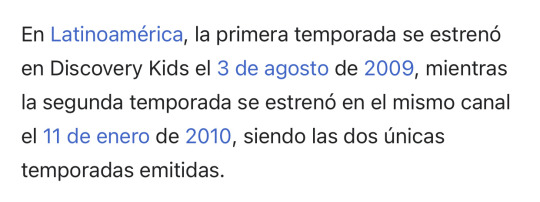
Translation: In Latin America, the first season premiered on Discovery Kids August 3, 2009, while the second season premiered on the same channel January 11, 2010, being the only two seasons issued. (Source)
However, later on I discovered that there was some mislead in that info because someone else found a Spanish episode that was from season 3, which doesn’t make sense because why would there be another season available when it clearly says that they technically shouldn’t exist? (Btw I tried finding it myself cause I did see that episode before but for some reason now I can’t find it dhdvvdbdvd ����)
At first I thought maybe this is just some info added from a fan. After all, that statement was posted on a Spanish Wikipedia page so it is possible. So I began looking for other articles that talked about the Spanish dubs, but they all said the same thing. Well, until I came up with this site that said two very intriguing things:

Translation: The series actually had 3 seasons and is dubbed in Caracas, Venezuela. On May 2012 the series stopped running on daytime hours and was removed from the programming one year later, on June 17, 2012. It is unknowns if it will be aired by another channel or come back to the Discovery Kids programming, besides only the two first seasons were dubbed in Spanish. (Source)
I was a little bit confused here with the wording because it still didn’t confirm my original questions; if anything it left me with more. But then I read the next section below which got me completely off track.
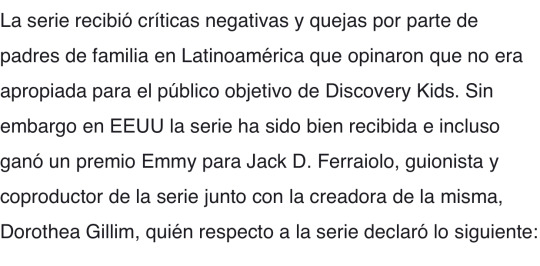
Translation: The series received negative critics and complains on behalf of parents of families in Latin America that claimed that it wasn’t appropriate for the objective public of Discovery Kids. Without doubt in the U.S. the series had been well received and even won an Emmy award for Jack D. Ferraiola, writer and coproductor of the series together with the creator of the same show, Dorothea Gillim, who declared the following in respective to the series: (Source)
Now this one took me by a whirlwind: WTH why was this version hated by people in Latin America while it’s adored by everyone in the U.S.?? And I watched some episodes of LCS and while the dubbing is pretty funny (lol) there wasn’t anything inappropriate about it. For the most part they stuck on script with the original episode they had to dub.
So I dove even deeper...
And o h m y g o d there is an answer to this.

Translation: The program premiered in Latin America on August 2009 on the Discover Kids channel, aiming at pre schoolers. Although the channel gave a lot of promotion for the show during the final months of 2009 and the majority of 2010, at the end of the year they decided to change the programming to nighttime hours because the show received a lot of critics from parents saying that the show was too “violent” and that it encouraged kids to lie to their parents (due to the obvious fact that Becky had to give an excuse everytime she had to leave to turn into WordGirl and save the day), and they complained constantly on the message boards now deleted of the channel. The program was eliminated completely on June 2012, without doubt, PBS maintained the Spanish dubs so that they would use for SAP (Second Audio Program) in the U.S. in a different studio (Dubbing House in Mexico and later Lorry Post in Miami, FL), but the program no longer returned to Discovery Kids until August 2014. (Source)
And DUDE no y’all this was just a complete hilarious yet ridiculous slap to the face. I mean..what the, why was that the reasoning as to why it was hated so much? Just cause of some literal PG kid friendly cartoon violence? And what do parents mean when they say it teaches them to lie to their parents?? I mean with all due respect, who was Discovery Kids target audience they had in mind vs. what it actually was? Because if there actual audience was very very young kids, they okay sure I can understand the need to point fingers at them in that sense. But if it was for slightly older kids (8-10 years old), then I think that parents can probably show kids at that age the reasoning behind why Becky lied in the show (not to mention that most kids at that age can understand what’s going on for the most part).
“Now is this actually true?” some of you may ask, which is understandable since this is coming from a wiki page. Well, I think it’s about time I put another disclaimer: sadly for the most part, the majority of these sources that I’ve attached have broken links when it comes to their references. And the ones that aren’t broken don’t mention anything about the topics that have been discussed here. But there are some smaller sources I’ve found here (look at the last three comments) and here that do indeed confirm that the show was canceled due to the force of parents.
However, the current grey area I’m in still is on the Spanish dubbing listing. See, I originally thought that there were three different dubbings according to this one post below (M&M Studios, Dubbing House and Lorry Post). I even thought I cracked it since according to this chart below the rest of the seasons were under the Dubbing House studios! However, it turns out that one of the studios Lorry Post doesn’t actually exist. Like nothing related to dubbing came up at all when I searched it up.

Translation: Dubbing Studio 1 - M&M Studios (Seasons 1-2). Dubbing Studio 2 - Dubbing House (Seasons 3-8). Dubbing Studio 3 - Lorry Post (Season 8 - final episodes). (Source)
And then that’s when I took a harder look at this website and realized that it’s part of a Spanish Wiki page called “Propuestas de Fans de Doblaje” (Fan Proposals for Dubs). *insert facepalm emoji* And just...I honestly feel so dumb that I didn’t notice that detail when I did my initial research cause that would’ve saved me a lot of time 😤. Anywho so that explains the Lorry Post mystery, but then lies the other question: do the other dubs exist?
Well, this is where I draw the line. See, on that same wikipage, it mentions that LCS had completely different voice actors for each of the dubbings. The first dub (M&M) is from Venezuela and after looking at the VA’s, they can be traced back to LCS. But after looking at the VA’s for the second dub (Dubbing House) in Mexico, there is nothing related to them and LCS or WG. Not even on movie databases.
“Now are you gonna give up on this idea?” you may ask. And the answer is......
No.
Why? Well, it’s mainly because there is a compellingly set of evidence that proves that the first two dubs do actually exist, which is...
youtube
THIS VIDEO, which shows that there were not one, but two variations of the LCS Spanish theme song. The first one is the Spanish version, and the second one that plays is the Venezuela version. And if you can remember, there were 2 dubbings of LCS; one located in Mexico (Dubbing House) and another In Venezuela (M&M Studios)!
Anywhosole, that is where I conclude this elaborate essay of mine. There are still a couple of loose strings here and there that I wanna check out myself but I’ve already tired myself out with this essay. I hoped you liked seeing me lose my mind speculate on the LCS episodes! This was honestly pretty fun ngl, maybe I’ll try doing this again in the future if something else interesting pops up! If you have anything you wanna add or maybe point out something that I may have forgotten, please by all means bring it up!
#warning: I have already lost my sanity over this entire essay /hj#my discord peeps have already been exposed to a good part of this already a heh heh#but I have learned some new things so this is more of an updated version for those who wanna see me lose my mind 🙂#AGAIN#wordgirl#word girl#wordgirl lore#theorizing cap time!!
42 notes
·
View notes
Text
Some of you might have noticed that I have a new fandom. As often happens, the fandom itself isn’t new: Roswell, New Mexico, has aired for two full seasons on the CW, and a lot of the fans jumped on board at or near the beginning. I, on the other hand, sauntered in late, martini in hand, and binged the whole thing on Netflix in a week to get my mind off the fact that my HVAC had died in the middle of a heat wave and nobody could figure out how to fix it. The stubborn appliance is now fixed, and my condo is now a placid 74 degrees Fahrenheit throughout, but in the time it took, I not only watched all of RNM but wrote and posted my first fic in the fandom. It is a classic case of new fandom glow, and all it took was an aggressively mediocre TV show about attractive queer aliens and two weeks of sustained negotiation with the heating-cooling repair company.
Since I have friends in the fandom and they seem happy that I’ve shown up - especially since I brought martinis for everyone - I’m now on a Discord server where a lot of the RNM fandom stalwarts hang out. (Discord: yet another fandom platform that reminds me that the days of Livejournal were terrible but also makes me feel ancient.) Here I am, two days after joining the server, giddily chatting with my fellow nerds and plugging away at fic #2, when someone starts fretting that everyone is leaving RNM fandom and there will soon be nobody left.
In my mind, this fandom is vibrant. My Tumblr dash is full of new gifs, fanart, and stories. The Discord is not overwhelming, but there is plenty of action, most of it on topic. AO3 listings indicate a steady stream of new material. It’s possible that things have slowed down since the initial boom, but this fandom is still moving at a healthy clip - especially since, as someone else on Discord pointed out, we’re in the middle of a long show hiatus (made longer by the pandemic and by some behind-the-scenes tsuris) after a season that mostly separated the fandom’s consensus OTP.
My reaction to this concern is that RNM is the kind of fandom that has legs. At first, that was an inkling, fueled by the desire for more Malex fic to be injected directly into my bloodstream, but the more I thought about it while folding laundry (You know what else got fixed last week? My dryer. I am so happy. Never get old, kids.) the more I saw myself responding to a pattern. The upside to being old - and by old, I mean that the Star Trek fans I used to hang out with on a Yahoo Group dubbed me a Brassy Old Fandom Queen in approximately 2002 - is that you have perspective.
At this point, I have written upwards of 200 stories in something like 50 fandoms. (Not all of these stories are on AO3; some of them are buried on Dreamwidth where they belong.) You know what still gets read? Stories in fandoms with a large amount of canon that is readily available on a major streaming platform. I haven’t watched a Gilmore Girl since there was a Bush in office, but I still get kudos almost daily on Rory/Paris fics that are older than the characters were in the first season of that show. Sometime around 2011, I wrote Mass Effect femslash because I was modding a fic exchange and took a difficult sign-up for the team, and that thing still gets read all the time. Not only are my own Star Trek: DS9, Teen Wolf, and Firefly fics still being discovered by new readers, but I continue to find new fanworks for all of those fandoms on my Tumblr dash and on AO3, mostly created by people who just now took a deep dive on Netflix and fell in love for the first time. Some of these canons have become dated, and several were not great in the first place, but they’re easy to become obsessed with and to say fresh things about. They’re also easy to maintain interest in. I’m not really creating new works in any of these fandoms anymore, but I eagerly pick up new fanworks by others when they come my way. One of the best fics I’ve read in the past year is a sparkling Garashir AU that you should read if you have any DS9 feelings at all. I’ve been disillusioned with the central Avengers storyline of the MCU for years now, but I’ll be damned if I ever stop reblogging Stucky gifsets.
You know what doesn’t get new fans or fanworks? Short, time-dependent fandoms that everyone consumes at once and then gets tired of quickly. I got a bajillion kudos in the first 48 hours when I wrote my one and only Venom fic, and I don’t think anyone has touched that thing since. It’s a pretty good fic, but nobody cares anymore. A decade ago, everyone was wild for Kradam, but I suspect that if I ask the dewy-eyed college students on my dash what a Kris Allen is, they will blink at me with sweet incomprehension. Last year, when Good Omens was the place to be, I followed a bunch of fandom-specific side blogs, all of which are now either abandoned or so slow they’re effectively defunct. I have dim memories of lingering on endless LJ photosets of Lindsay Lohan and Samantha Ronson at some point in 2008, but I think we have erased this from our collective memory. In all of these cases, people got all their ideas and excitement out in one explosion of fannish energy, and then they moved on - usually drifting back to the large-canon fandoms they’d come from.
The flavor of this month is The Old Guard. Everyone is making gifs and writing fluffy backstory for Nicky and Joe. Almost everyone will be bored with this by Halloween. By then, there will be some other movie or RPF ship or live musical extravaganza that we are all either obsessed with or incepted into via fannish osmosis. Fandom needs these large, centralizing events to remind ourselves that we can all feel something in unison. But they don’t last.
That’s not to say that one kind of fandom source is better than another. Gilmore Girls is not a purer or more admirable source text than Lost Girl simply because you have forgotten that one of these shows exists. It’s just that some canons are better equipped than others to draw in and retain new fans, while others can’t sustain themselves without collective fannish energy to prop them up. And the best way to sustain any fandom is to lure your friends and neighbors into it, whether by talking up the merits of the canon or linking everyone to That One Fic or reblogging pretty gifsets until they give in. If everyone’s leaving the party, make a fresh batch of martinis. Chances are, a lot of people wanted to keep hanging around anyway, and a bunch of others were lurking by the door, wondering whether it was safe to come in.
10 notes
·
View notes
Text
Seven Little Tricks To Achieve The Best Results In Flowering House Plants
Parpot is an indoor plant cultivating device utilizing ledas a lightweight supply for the photosynthesis zone of crops instead of daylight within the room with not enough gentle. Some indoor planters are available in prepared-made kits that makes it very simple to get started with having vegetation in your house. Cause rotting of the tender roots and vice versa for well grown crops. While it is Send A Plant nice fun to get outdoors when the weather breaks, and begin planting that landscaping project, many individuals preserve the out of doors freshness in their life, all 12 months long, by beginning indoor container gardens. A decorative indoor or greenhouse plant with feathery foliage, which is said to the edible asparagus. Riley says that along with the environmental benefits of rising your personal meals at home, there are aesthetic wins as nicely. Nothing beats the indoor vegetation in house ornament. Pot the plant into the fitting soil for best african violet care. In case you place the vegetation in extraordinarily dim mild, allow the soil to dry out slightly between waterings.
Then water well to take away air pockets from the new soil. Ferns, with their amazing variety of foliage types and lacy leaves, have always been common as houseplants. I do advocate that you simply at all times provide the very best mild , watering and look after all your indoor vegetation so they may look their best. Dubbing itself the world's "first post-organic greens" grower, bowery makes use of led lights to imitate sunlight, grows its greens in nutrient-rich water trays stacked from flooring to ceiling, uses data evaluation to observe plantings from seed to Cheap Plants For Sale harvest and robotics to harvest the crops. Gardening ranges in scale from fruit orchards, to lengthy boulevard plantings with a number of various kinds of shrubs, trees and herbaceous crops, to residential yards including lawns and foundation plantings, to giant or small containers grown inside or exterior. As a word, by no means feed or fertilize a potted plant when the soil is dry, all the time water first, then feed.
A former editor of the uk's trade magazine for florists, austin now writes for quite a few publications and companies, talking about flowers, crops and shopper shopping for habits and is a board director of moral flower label fair flowers truthful plants. The presence of flowers is enough to make any event or second truly a memorable affair. Lastly, the stems need pruning in order that the reduced root system has less leaves to assist, and, after all, because the purpose has been to maintain the plant from rising bigger. Warm local weather, full solar to full shade, tolerates low light indoors however will develop slowly. The entire plants in our breathe happier assortment are hardy, simple to care for, and chosen from plants listed within the Flowering House Plants nasa clean air study. We potted with miracle-gro & then added additional miracle-gro to backyard #3. The tomatillos in predominant garden & backyard 2 are rising healthy. Additionally referred to as as closet plants, peace lilies harmonize the power of a house or workplace. Our similar day crops supply is quick and efficient.
Felly's flowers is dedicated to creating lovely flower arrangements and floral gifts for any event. There may be also a indisputable fact that the plants are very adaptable in nature as they can alter themselves with the fluctuating lighting conditions happening all around. Our inexpensive flowers never sacrifice quality, and we even offer free supply on choose flower bouquets regardless of the occasion (or your value range), our florists have one of the best options for you. Fertilizers for flowering crops have different phosphorus contents than fertilizers for foliage plants. When choosing flowers for special events, you possibly can browse our impressive number of crops, flowers, and present baskets searching for the precise present for your wants. Emphasize the greenery with the combination of blooming and foliage vegetation in our european backyard arrangement, a pleasant antidote to sizzling days within the excessive desert areas of new mexico. Whereas contemporary flowers and floral arrangements are in style gift decisions at ftd, we promote plant items as effectively. Using delicate temperature water in your vegetation is necessary as a result of water that is too sizzling can cause root injury and plant shock, which may potentially kill your plant. Do not despair but, i've a few crops to suggest which are easy to deal with and do not want much fussing around. Unlike an exterior landscape plant, your potted plants depend on you to provide the Send Plants correct amount of water to the basis system. Your plants will appear flocked; this white fungal coat will drain all vitamins out of the leaves. Just develop it in a very good compost keep watering when it is dry and feed it once in a while, too. Watch out, solely acclimated vegetation can handle direct solar. Attempting to grow some of these crops year-round, or using soil-less growing methods (like hydroponics or aquaponics) is extraordinarily costly, power intensive, and tough. With its long slender leaves, this plant reduces pollutants from the air and purifies it. People who do not have a lot outside area or who reside in a colder climate with a brief rising season can still take pleasure in rising crops. Sowing tomato seeds 6-eight weeks (no earlier than eight weeks) earlier than setting out is ample growing time. Flowers are a very popular product in the suburbs as a result of they comparatively cheap and really simple to make use of with none extra training or purchases. Plants want the sun and light-weight. They'll develop a flower from a clipping of another plant on the similar time. If you wish to fill your house with the enjoyment of flowers, browse our assortment of gorgeous, parisian-inspired bouquets right now. So, you may get the subsequent day gift, flower and cake supply in other nations like singapore, australia, germany, and philippines and continue celebrating your particular competition.
TAGS: Tropical Plants For Sale,Order Plants Online,Buy Trees Online,House Plants For Sale
1 note
·
View note
Text
K.O. KITTY
“The Westinghouse Desilu Playhouse” ~ November 17, 1958

Produced by Bert Granet, Quinn Martin
Directed by Jerry Thorpe
Dances and Fights staged by Jack Baker
Written by Bob Carroll, Madelyn Davis, Quinn Martin (story)
Synopsis: Los Angeles dance teacher Kitty (Lucille Ball) is delighted when she learns that she has inherited a boxer from her late Uncle Charlie. But the boxer turns out not to be a canine, but a prize fighter named Harold Tibbetts (Aldo Ray), a muscle-bound country boy.
Cast

Desi Arnaz (Himself, Host) was born in Cuba in 1917 and immigrated to America as a youngster. He was a musician who married Lucille Ball in 1940 after meeting her on the set of 1939’s Too Many Girls, which he had done on stage in New York. In order to keep him ‘off the road’ Ball convinced producers to cast him as her husband in a new television project based on her radio show “My Favorite Husband.” The network was convinced. In 1951, Arnaz and Ball began playing Lucy and Ricky Ricardo, roles they would be identified with for the rest of their lives. The couple had two children together, Lucie and Desi Jr. In 1960, Ball and Arnaz divorced. Desi became a producer, responsible for such hits as “The Mothers-in-Law” (1967-69). He re-married in 1963. Desi Aranz died in 1986, just a few years before Ball.
Lucille Ball (Kitty Winslow) was born on August 6, 1911 in Jamestown, New York. She began her screen career in 1933 and was known in Hollywood as ‘Queen of the B’s’ due to her many appearances in ‘B’ movies. With Richard Denning, she starred in a radio program titled “My Favorite Husband” which eventually led to the creation of “I Love Lucy,” a television situation comedy in which she co-starred with her real-life husband, Latin bandleader Desi Arnaz. The program was phenomenally successful, allowing the couple to purchase what was once RKO Studios, re-naming it Desilu. When the show ended in 1960 (in an hour-long format known as “The Lucy-Desi Comedy Hour”) so did Lucy and Desi’s marriage. In 1962, hoping to keep Desilu financially solvent, Lucy returned to the sitcom format with “The Lucy Show,” which lasted six seasons. She followed that with a similar sitcom “Here’s Lucy” co-starring with her real-life children, Lucie and Desi Jr., as well as Gale Gordon, who had joined the cast of “The Lucy Show” during season two. Before her death in April 1989, Lucy made one more attempt at a sitcom with “Life With Lucy,” also with Gordon, which was not a success and was canceled after just 13 episodes.
Most sources list Kitty's surname as ‘Williams.’ Her last name is clearly spoken twice in the teleplay as ‘Winslow.’
Aldo Ray (Harold Tibbetts, below center) was born as Aldo DeRe and nicknamed 'the Rugged Romeo'. In 1964 he worked again with Lucille Ball in Bob Hope's “Have Girls, Will Travel” (1964). His career waned in the 1970s. He died in 1991.
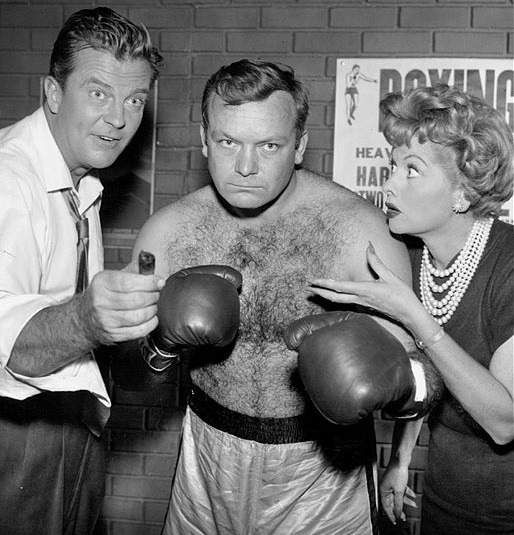
William Lundigan (David Pierce, above left) was a genial 'B' movie and TV actor. His career began in 1937. His last television role was in 1971. He was a good friend of William Frawley (Fred Mertz) and served as pallbearer at his funeral. Lundigan died in 1975.

Harry Cheshire (Mr. Brubaker) did three films with Lucille Ball between 1947 and 1950. He played Sam Johnson, a Texan who sells Lucy and Ricky “Oil Wells” (ILL S3;E18) in 1954. His best-known role was as Judge Ben Wiley in the TV series “Buffalo Bill, Jr.” (1955). He died in 1968 at the age of 76.
Jesse White (Barney Snyder, below right) is probably best remembered for playing the lonely Maytag repairman on TV commercials airing from 1967 to 1988. A busy character actor, White subsequently starred opposite Lucille Ball on a 1972 episode of “Here's Lucy.” He died in 1997.

Sid Melton (Louie, above left) also appeared on the “Westinghouse Desilu Playhouse” as a bellboy in “Lucy Goes to Alaska” (February 1959) and as a construction worker in “Milton Berle Hides Out at the Ricardos” (September 1959). He played one of the jockeys in “Lucy Wins a Racehorse” (February 1958). He later played Charley Halper on "Make Room For Daddy” (filmed at Desilu) and Alf Monroe on "Green Acres” (aired on CBS).

Frankie Van (Himself, Referee) was a stand-in and background performer whose more than 50 credits are nearly all as referees in films and television shows about boxing. Fittingly, his last screen credit was as a referee in Rocky (1976).
In this script, Van is called by his real name.
Freddie Beshore (Tommy Thompson, uncredited) picked up boxing while serving in the United States Navy during World War II. During his career he was the Heavyweight Champion of the Pacific Coast. During the late 1940s and early 1950s he was a top heavyweight title contender.
Norman Leavitt (Policeman, uncredited) appeared with Lucille Ball in the 1950 film A Woman of Distinction as well as The Long, Long Trailer (1953). The character actor also appeared on three episodes of “The Lucy-Desi Comedy Hour” and two episodes of “The Lucy Show.”
About “The Westinghouse Desilu Playhouse”

After the end of the half-hour “I Love Lucy” episodes, Desi Arnaz convinced CBS to purchase an anthology series titled “Desilu Playhouse” which would feature different hour-long dramas every week along with monthly stories of the Ricardos and the Mertzes, something begun a year before.

Thirteen hour-long “I Love Lucy” adventures were eventually made and sold to syndication as “The Lucy-Desi Comedy Hour,” ten of which were produced under the Westinghouse sponsorship. The appliance company paid a then-record 12 million dollars to sponsor the show.

Desi Arnaz hosted the show and introduced the stories. Desi, Lucy, Vivian Vance, and William Frawley, were often involved in the lengthy studio-filmed commercials, with Betty Furness spokesperson for the Westinghouse products. Although it wasn't around long, the show gave birth to pilots for “The Untouchables” and “The Twilight Zone.”

In the summer of 1958, in anticipation of their partnership, the cast of “I Love Lucy” played themselves in an industrial film (known as “Lucy Buys Westinghouse”) that toured the Desilu Studios, promoted “Lucy Goes to Mexico”, and highlighted Westinghouse appliances. The film was never in theatrical release or broadcast, but only shown Westinghouse dealers and corporate clients.

The Desilu Playhouse was also an actual little theatre on the Desilu backlot which hosted classes for actors and put on workshop shows for agents and industry insiders. When Lucille Ball joined RKO in the 1930s, the program was headed by Ginger Rogers' mother, Lela. Lucy wanted to continue the tradition. It was depicted in both “The Desilu Revue” (December 25, 1959) and “Hedda Hopper's Hollywood” (January 10, 1960).
About “K.O. Kitty”
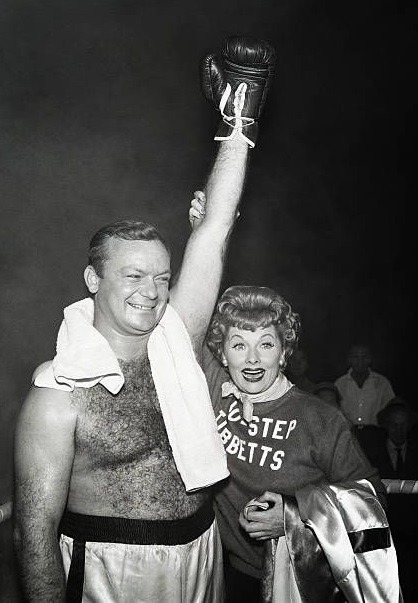
In the title, “K.O” is boxing term short for “Knock Out,” when a fighter has hit his opponent so hard that he hits the mat and cannot get up again.
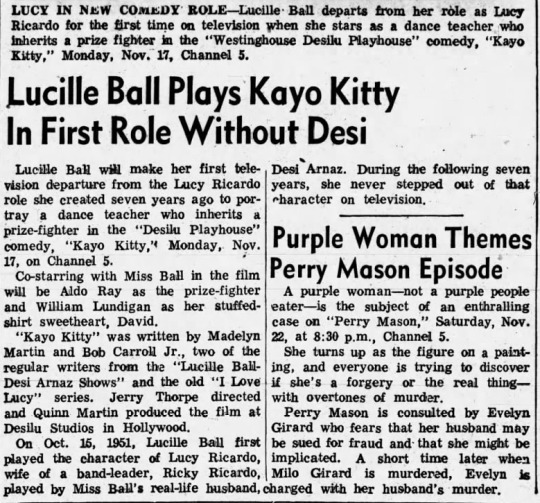
This is the first time that Lucille Ball acted on television not playing Lucy Ricardo. Lucille Ball was supposed to do several more non-Lucy Ricardo roles on the series, but this was the only one that ever materialized. The series ended in 1960, along with the Arnaz marriage. “The Desilu Playhouse” went into syndication, minus the Lucy-Desi Comedy Hours. In 1962, Desilu sold those 13 shows back to CBS for $750,000.

Quinn Martin (Producer / Story) was married to “Lucy” writer Madelyn Pugh Davis from 1955 to 1960. His production company was later responsible for such hits as “The Streets of San Francisco” (1972-77), “The Fugitive” (1963-67), and “Barnaby Jones” (1973-78) earning him four Emmy nominations. He also produced nine other episodes of “The Westinghouse Desilu Playhouse.”

Like “I Love Lucy” and “The Lucy-Desi Comedy Hour,” the episode uses a laugh track. Unlike most of those shows, there was no studio audience. “K.O. Kitty” followed “Lucy Goes to Mexico” (October) and was followed by “Lucy Makes Room for Danny” (December), a cross-over episode with “Make Room for Daddy.”

Earlier in 1958, boxing made the cover of Life Magazine when Sugar Ray Leonard beat Carmen Basilio.

Boxing had been a major attraction on television, the highlight being the “Playhouse 90” presentation of “Requiem for a Heavyweight” in 1956 on CBS. It was directed by Rod Serling (”The Twilight Zone”) and starred Jack Palance.
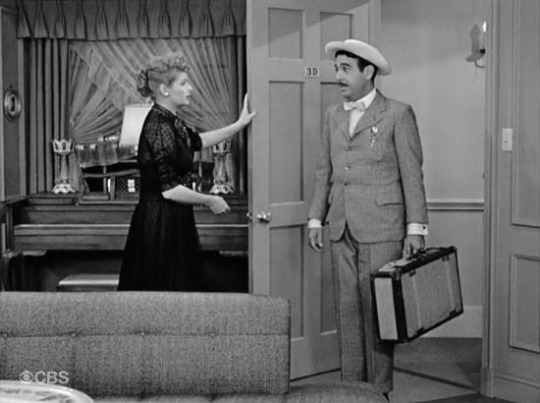
A country boy out of his element, Harold Tibbetts (Aldo Ray) is reminiscent of when Tennessee Ernie Ford visited the Ricardos on “I Love Lucy.” Like Cousin Ernie, Harold has an enormous appetite and can't return home because he has no money. He also tends to speak with homespun wit.
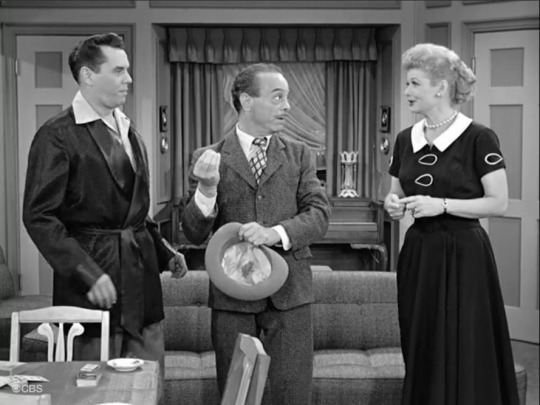
Harold also resembles another visitor to the Ricardo apartment, Mario (Jay Novello), the “Visitor From Italy” (ILL S6;E5). Like Harold, Mario had no cash to and had to go to work – in his case making pizza.
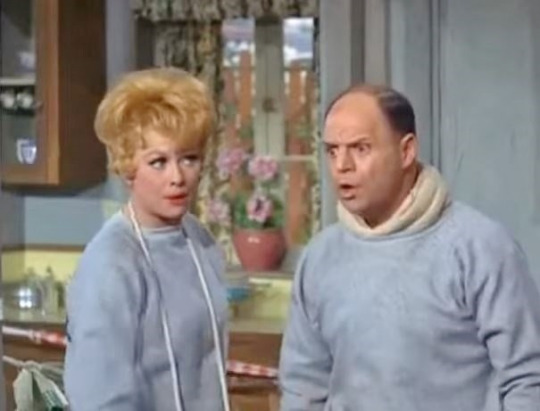
But “K.O. Kitty” most closely resembles a 1967 episode of “The Lucy Show” titled “Lucy, the Fight Manager” (TLS S5;E20) starring Don Rickles as a washed-up boxer named Eddie who Lucy Carmichael decides to train at home. Lucy dubs herself 'Killer Carmichael' and even jumps rope in tandem with Eddie, a stunt she learned to do for “K.O. Kitty.” Despite being by different writers, both scripts contain characters named Louie.

Lucille Ball also played characters named Kitty in the films Follow the Fleet (1936), Without Love (1945), and The Facts of Life (1960). A name featuring two-syllables ending with 'y' made reminded the listener of 'Lucy'.

Eight months later “The Westinghouse Desilu Playhouse” did another story about prizefighting titled “The Killer Instinct” starring Rory Calhoun and Janice Rule. It was based on the career of ex-boxer Joe Barnum.
The Episode
Desi Arnaz introduces the program, noting that it is a special episode because it stars “his favorite redhead” Lucille Ball.
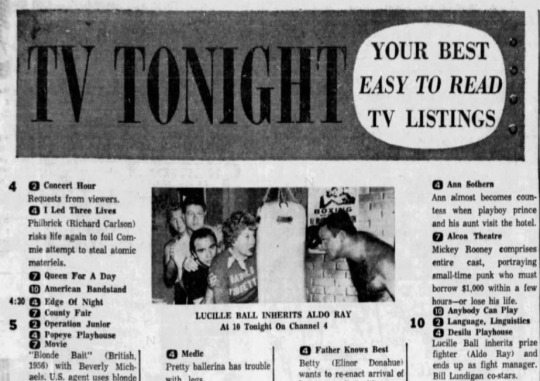
The story opens with Kitty at work, teaching dance. She is trying to get Mr. Brubaker (Harry Cheshire) to do the Cha-Cha.
Kitty: “Your feet are doing the cha-cha-cha but your hips are back in the rumba class.”

During the dance lesson, we learn that Kitty is engaged to an up-and-coming lawyer named David (William Lundigan) who won't marry her until he gets a partnership in his law firm, Abbott Parker and Jones. She tells Mr. Brubaker that he is dancing with an 'heiress' due to her Uncle Charlie dying and leaving her a diamond stick-pin, a gold pocket watch, and a dog – a boxer, to be precise.

David (William Lundigan) tells Kitty he is going away on a business trip to San Francisco for a week. During their romantic dinner, there is a knock on the door and the boxer arrives – Harold Tibbetts, professional prize fighter. Tibbetts admits he's not really from Ogalala, Nebraska, but from Crockett – just “a hoot and holler” away.
Harold: “I'm so hungry, my stomach's a-growlin' like hound dog's just smelled a weasel in a hen house.”
Overcome with a sense of loyalty to her Uncle Charlie, Kitty agrees to manage Harold. She arranges for Harold to fight the impressive Tommy Thompson, a powerhouse that no one wants to go up against. Kitty cannot afford the gym fees so trains him at her apartment.
The name Tommy Thompson was also the name of a producer who worked extensively with Lucille Ball starting in 1964. In 1958 he was on the Desilu lot working as assistant director on “The Danny Thomas Show”

Kitty sends Harold off to the store to buy training supplies while she stays behind at the gym to observe and pick up some pointers on boxing. First, she indulges in a little shadow boxing. Next she tries to use a punching bag, but it punches back – right in her face. Remembering how to jump rope from her childhood, she jumps into a boxer's reps keeping time with a schoolyard rhyme. These are all prime opportunities for Lucille Ball to indulge in some of her well-hone physical comedy skills.

Back at the apartment, there is a montage of scenes of Kitty training Harold. He knocks the punching bag out the window, shatters a mirror while shadow boxing, and crashes to the floor while jumping rope. Kitty decides that the best training for klutzy Harold would be dancing lessons.

They begin lessons by dancing to “I Can't Give You Anything But Love, Baby” by Jimmy McHugh and Dorothy Fields. The song was introduced on Broadway in Blackbirds of 1928.

The dance lesson scene is nearly identical to when Lucy Ricardo taught awkward Arthur Morton (Richard Crenna) to dance in “The Young Fans” (ILL S1;E20) in 1952.
David returns unexpectedly from San Francisco to find Kitty and Harold in a carefree clinch. Kitty attempts to explain what is going on but it devolves into an argument and David storms out.
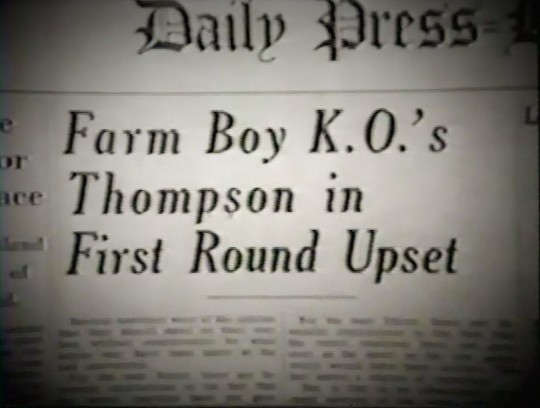
Using Kitty's dance steps and her singing “I Can't Give You Anything But Love” from ringside as inspiration, Harold surprisingly wins his bout against Tommy Thompson.
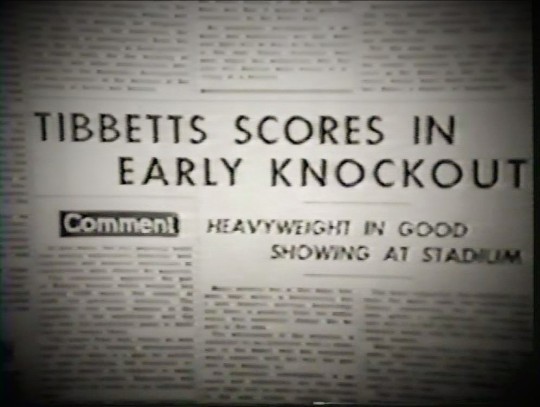
He then wins a second fight.

And a third!
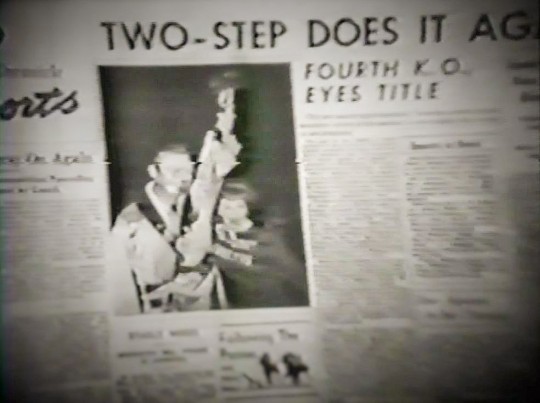
With a fourth K.O. under his belt thanks to Kitty, he eyes the title!

Barney Snyder (Jesse White) and David conspire to get Kitty out of the fight game – for both their sake. Snyder and Louie (Sid Melton) show up at Kitty's apartment, guns drawn, to convince Lucy that they are crooks, and that the fight is fixed.
Meanwhile, back at the gym, 'Two Step Tibbetts' (as he's now called) is waiting for Kitty to arrive knowing he can't win the fight without her singing ringside while he spars. David arrives to tell Harold the bad news that Kitty will be detained. He learns from Harold that earlier that day they decided that this would be his last fight. David offers to sing instead of Kitty, but Harold can't remember the name of the song – except that the word 'love' was in the title.
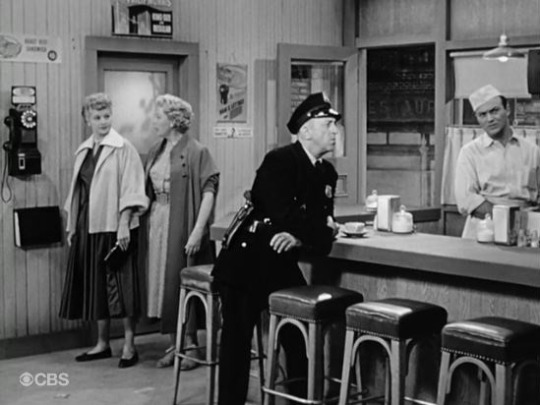
Still at gunpoint, Kitty watches the match from home on TV. When Barney and Louis become engrossed in the fight, Kitty hides in the closet. This is very reminiscent of “Ricky and Fred are TV Fans” (ILL S2;E30) where Lucy and Ethel manage to evade the police when they can't take their eyes off a televised boxing match.
Meanwhile, back at the ring, Harold is taking a beating while David rattles off the title of every 'love' song he can think of, including a few bars of “I Love You Truly,” a traditional wedding song.
Barney and Louis confess to Kitty that they made up their story about being mobsters. Their guns are actually cigarette lighters! They spill the beans to Kitty about their plans. In order to get to the stadium as fast as possible, Kitty pretends she's going to have a baby and gets a police escort. Kitty and David rush to the ringside in time to sing the song, which everyone in the stadium joins in. At the final moment, Harold lands a knock out punch and wins the fight. David and Kitty make-up with a kiss as the program ends.
Ringside With Lucy

Lucy Ricardo and Ethel Mertz ended up at the fights in the last scene of 1951’s “The Girls Want to Go to a Nightclub” (ILL S1;E1), the very first “I Love Lucy” episode ever aired.

Everyone but Lucy and Ethel seem to be watching the fights on television in “Ricky and Fred are TV Fans” (ILL S2;E30).

This Date in Lucy History ~ November 17

"Lucy and the Used Car Dealer" (HL S2;E9) ~ November 17, 1969
#K.O. Kitty#Lucille Ball#The Westinghouse Desilu Playhouse#Westinghouse#Desilu#Boxing#Aldo Ray#William Lundigan#Desi Arnaz#Bert Granet#Quinn Martin#Jack Baker#Jerry Thorpe#Bob Carroll#Madelyn Davis#Harry Cheshire#Sid Melton#Jesse White#Frankie Van#Freddie Beshore#Norman Leavitt#1958#CBS#TV#Don Rickles#The Lucy Show#I Love Lucy#The Lucy-Desi Comedy Hour#The Killer Instinct#Life Magazine
4 notes
·
View notes
Text
So I went off on a tangent sorry about that lol
Percy can warm his hot chocolate when it gets cold and make insta Popsicles for Estelle
He’s always the last to take a shower in the morning because the cold water doesn’t bother him.
Winter is the Jackson-Blofis kids favorite time of year. After watching Frozen Estelle begs Percy to “Do the magic! Do the magic!” At first he’s not sure he knows how but they go to Central Park after a snowfall and find a private space all to themselves for him to practice.
He learns how to control snow and ice much better. He creates slides and ice they can skate on in the meadows. He learns how to control the temperature of water to the extent that he can keep the air warm with steam while he and Estelle skate on their makeshift rinks.
He becomes a little obsessed with controlling the phasing of water more. He learns to hold all three phases of water in a single glass. He learns to make miniature hurricanes and thunderstorms in the palm of his hand. He learns to mold little figurines for Estelle out of water and freeze them as gifts for her.
One day she asks him to make her mermaid dance and he is thrilled to discover he can make the little ice figure around in the air to make it look likes she’s swimming.
One day they watch Avatar the last Airbender and Percy is enchanted by Katara. He learns that he can use water as a literal weapon and shield. He started off using it like a whip, a living coil of water that could reach as far as he wanted and do exactly as he commands. Then he learn he can fashion weapons out of ice. Monsters quickly learn that as long as there is water around, Percy Jackson is armed.
But Percy takes it a step further when he sees Katara and Toph escape the wooden prison by water ending sweat. He learns to manifest water. At first he is simply absorbing moisture from the air but soon he learns to create water from nothing. With a wave of his hand he can manifest the water and then form a dagger from it in seconds. Monsters quickly learn, Percy Jackson is Always armed.
The first time he created a sentient being he killed it. Estelle and him were playing with her ice mermaid as usual. Percy was focused on making it as realistic as possible when suddenly it began to glow a light blue. Estelle was delighted but Percy had his eyes closed in concentration. It wasn’t until the mermaid dropped out of the air and into his lap, gasping and withering around that he realized it had come to life. But like real mermaids of the sea she could not survive out of water. By the time he shook out of his shock and got her submerged in water she had already passed in what he knew was extricating pain.
He went to his father for advice after that, carrying the tiny creature in some satin his mother gave him for her. His father was shocked when he found out the extent of Percy’s powers. He was so proud of the accomplishment he didn’t realize how devastated Percy was about unintentionally killing his little creation. Poseidon brought the mermaid back to life for him along with some advice on the art of creation.
Before Percy left he warned him to not let all his abilities be public knowledge, it was better to be underestimated. What he didn’t tell Percy that the ability to fashion and create life was something only the gods could do. The fact a demigod had that ability without the restrictions of being a deity would not sit well with the other Gods, especially Zeus.
Percy went to buy a large tank and some friendly fish from his local pet store and had it all ready for when Estelle arrived from school. They named her Elsa and took very good care of her.
The first time he bloodbended was accidental too. They were at the park on a warm summer day eating Popsicle sticks Percy had made out of a carton of orange juice. Percy ran into an old friend and was chatting while Estelle played. Neither of them noticed the dog. Estelle was rather fond of animals so naturally she tried to pet the animal not noticing all the warning signs. When it mauled her Percy felt as if the very blood in his vines had boiled and busted. The dog had Estelle’s arm in its jaw for all of five seconds before it became a soup of blood, fur and bone on the forest floor. Estelle was okay and bandaged and cleaned up at home
Sally sat Percy down to have a Long talk about the weight and responsibilities of his powers. He completely understood and agreed that bloodbending was an Off Menu power.
But he was still intrigued by bloodbending on a smaller level. He started off practicing on himself. He could make his skin move around and wiggle his ears using his powers, soon he learned that he could change certain things about his body. He fixed his teeth himself, he toned his tan lines and made his hair instantly as long or as short as he wanted.
It came as a surprised to no one in the Jackson-Blofis household that he later figured out how to shape shift. But he still kept it small. A few pounds of muscle here, take off a few pound of fat there. He could quicken and lower his own metabolism with ease. He could control how much adrenaline was coursing through his body as he pleased. He began actually reading up on biology to see how much he was able to control.
It was one night when he went out looking for Estelle - who had stormed off angry about something - that he was nearly killed. He had been looking for an hour unaware she had already come home when the mortal approached him with a gun demanding all his money. Of course he didn’t bring any money out to look for his sister but the guy didn’t believe him. Honestly Percy didn’t expect the guy to Actually shoot and when he did Percy was more upset at the fact that he was actually shot then the fact that he was in danger.
The man had run off and Percy not liking hospitals went back home for ambrosia. But the bullet had hit an artery and he was bleeding heavily. He collapsed halfway home panicked and not sure how to stop the bleeding. That’s when he remembered his mermaid and how Estelle said she glowed before coming to life. He manifested some water in his hand and willed it to glow. He put it to his chest and the water latched to him, stopping the bleeding and numbing the pain. By the time he got home he wound had nearly finished healing. Sally watched in awe as the last few bits of water fused and merged with his skin.
After that he started keeping jugs of this strange glowing life giving water in his house. He carried a water bottle of it around with him all the time. It was a safer alternative to ambrosia and mortals could use it too. He would go to CHB and CJ and fill large barrels with this water which he named katara (cause he’s a HUGE nerd at the end of the day)
Pretty soon katara became more popular than ambrosia among demigods and mortal in the know. They found that if they added regular water to katara it would gain the properties of katara. Pretty soon a pool was built at both camps to house katara. Percy was glad to see his creation helping so many people but he had unfortunately caught the gods attention.
He was called to Olympus and questioned about what he was trying to do with this “katara”. He told it how it was. He had accidently created it so he gave it to other people as well. He wasn’t even making a profit off of it which he easily could if he wanted too.
The gods in reality didn’t have a problem with katara, they knew it was helpful and did nothing but benefit people. The underlying message in calling upon Perseus Jackson was to let him know he was being observed and to warn him to watch himself.
Percy understand that message loud and clear, but he really didn’t give a fuck. He especially didn’t give a fuck when he made his own island in the Gulf of Mexico. Grover actually helped him with that. Grover created a list of endangered species that needed a safe haven from human intervention and would coexist well. Hazel helped them create a barrier similar to the barriers at the camps around the island. Percy set to work with making the water surrounding the island rich with katara. And in a few months they had a lush and beautiful island that Percy dubbed the Garden of Me.
Poseidon actually came to visit Percy’s island and he was surprised when he saw his son, asleep in a field of rare flowers glowing with dormant power. Of course only a god could see that glow from within. Poseidon began to realize his son was unintentionally becoming an immortal at the least, a powerful god at the most. That’s when he decided to train Percy.
He taught him how to mold and shape lifeforms that already existed to help with Grover’s cause of saving the Wild. He taught him the limits and devastating abilities Percy contained. He showed him how to properly shapeshift into anything he wanted without having to alter his original form. He taught him how to materialize not only water but other liquids and water based materials.
Percy reveled in his new found powers. He not only got to spend time with his father but being TAUGHT was sooo much better than just figuring it out on his own. He found that he and his father are actually pretty similar and get along really well.
As for Annabeth at first she was worried about the path Percy was going down with his powers but she is realized to see him focus his powers on the creation of his little island. Well, not so little anymore. Percy continued to expand the island to accommodate the now hundreds of endangered species of plants and animals residing there. As far as the outside world was concerned some of these animals had gone extinct, but they lived peacefully on Garden of Me. Now the island was nearly 200,000 sq miles and took up most of the Gulf of Mexico. Annabeth could only guess how Hermes managed to explain that to the mortals.
Annabeth and Percy spend a lot of their free time on the island. In fact the whole Jackson-Blofis household do. Afterall the island is big enough to house a small nation. But Percy and Annabeth still love the idea of having an entire island to themselves to do whatever they want. When Annabeth gets pregnant Percy nearly erupts one of his rivers with joy. Although marriage had never been on their minds (they kind of just assumed they would just always be together regardless) they decide to get married on their private island.
It was a wedding that rivaled even the gods weddings. Mortals, demigods, gods, nymphs, satyrs, dryads, cyclopes and more all came to the celebration that lasted nearly an entire week. At first Percy was nervous about inviting so many people. Afterall it wasn’t just an island but a sanctuary for plants and animals that didn’t exist anywhere else on Earth. But Grover ensured Percy he and his helpers would take care of crowd control. Annabeth and Percy honeymooned in one of the beautiful underwater caves on the island while their wedding raged on for days. Clean up was a bitch but the next few weeks were the happiest of their lives.
That was of course, until the war began. Oddly enough it was a war between mortals but it had devastating implications. The threat of nuclear war had never been so real between the US and Korea. Percy and Annabeth (now 5 months pregnant) anxiously moved their mortal families to the island and offered sanctuary to their friends as well. Percy strengthened the barrier to his island and discussed with Grover about making a pop up second island to house other animal species that would be devastated by the event of nuclear war. In the end He, Grover and Annabeth decided a second island was a necessity.
It was enormous. Nearly 600,000 sq miles and hugged the shared coast of California and Mexico. The plan was to evacuate the camps. A third of the island would be used as a third camp safe from the war of mortals. This part of the island would have everyday animals and plants. Cows, pigs, horses, dogs, foxes, bats, vegetables, fruits, grains etc. It would serve as a human sanctuary while the other ⅔ of the island would be reserved for other endangered species. The planning was intense. They had to be careful to keep species that would compete to extinction seperate, they had to avoid invasive plants and animals or at the least keep them contained. And they had to explain to people why they’re pet cats were Absolutely NOT allowed on the island. (Cats are one of the deadliest animals of earth accounting for the majority of extinctions among small animals).
The gods were helpful too. They could see the danger the mortal war posed to the demigods and knew they needed demigods. The only god that as far as Percy was concerned was not being helpful was his father. Poseidon insisted Perceus took up godhood, but Percy had a family on the way and he couldn’t imagine a life where he continued to exist without them. Poseidon tried to convince him to just make Annabeth immortal as well, after all that's what he did to his wife. But Percy didn’t want to think about it. He just wanted to focus on keeping everyone alive.
That’s when the boats began to arrive. People in California fleeing the conflict but with no funds for now overpriced flight began to take boats and try to cross the borders of Mexico, Guatemala, and El Salvador. But Percy’s island was only a few hundred miles off shore. The boat that got lost on the way down the coast ended up on the second island. Percy couldn’t turn them away.
Despite all their preparation they weren’t ready for when the first missile struck. In fact no one was ready. Everyone expected the obvious targets. Major cities, military bases, maybe even the white house. No one could have guessed their target was the top left corner of Wyoming, where the Yellowstone National Park sat unassuming. No one could have guessed anyone would be that crazy.
The explosion was deafening. Even from the second island they could see as the cloud of sulfuric ash umbrellaed out in all directions. They could hear the continued explosions from the volcano itself. The gods did nothing. They would not interfere with mortal activity unless it directly threatened them. All the inhabitants of the island could do was sit and listen to the sounds of millions dying, and watch the cloud of ash choke the sky.
#percy jackson#percy is awesome#percabeth#Percy#dark percy#Hazel Levesque#grover underwood#PJO#Percy Jackon and the Olympians#annabeth chase#Sally Jackson#Sally Blofis#sally is a demigod#poseidon#water bending#katara#Avatar The Last Airbender#bloodbending#blood of olympus
232 notes
·
View notes
Text
Let’s Talk #SailorMoon: The Latin American Dub
The Spanish Latin American dub of the original Sailor Moon series is likely the only dub where Rini (Chibiusa) was Sailor Chibi Moon.

For more on the Latin American dub of Sailor Moon, feel free to keep reading. There will be spoilers.
The Latin American dub of Sailor Moon was one of the show’s two Spanish dubs (the other being a Castilian dub mainly aired in Spain) and originally aired in Mexico on TV Azteca.

The dub was originally based upon DiC’s English dub and began production a year after the latter’s debut in Syndication. It used the show’s original English logo, some of the Americanized names such as Serena and Lita, referred to the team as Scouts, and also made Zoisite female.

Everything else was either directly translated or renamed:
The villains’ names were either reused from the DiC dub, translated into Spanish, or a combination of both (Nephrite/Neflite became Neflyte while Demande/Diamond became Diamante).
Sailor Pluto became Sailor Plut.
All of the transformation and attack calls originally called out in English were now called out in Spanish.
Interestingly, the dub retained the surnames DiC had dropped such as (Serena) Tsukino and (Amy) Mizuno.

Unlike the heavily edited original English dub, the Latin American dub was mostly uncut. Moments such as the characters’ onscreen deaths, Tuxedo Mask getting stabbed, and Chibiusa’s introduction were neither toned down or rewritten. Even the episodes skipped by DiC were dubbed, although this dub skipped the clip show.

The only major modification the dub made was to the music. It would go in one of four different directions: Either let the original music play, faithfully translate the lyrics into Spanish, replace the music with instrumentals, or outright remove it and leave some scenes in complete silence.
When the original English dub went on a hiatus in the midst of R, the Latin American dub carried on, with their dub now being based upon the original Japanese version. The Americanized names from the first two seasons were retained and led to some oddities for the dub.
The most notable example comes from Chibiusa, who in both the original English and Latin American dubs was known as Rini.

When it came to Black Lady, the original English dub renamed her Wicked Lady. The Latin American dub retained the original name but did not translate it into Spanish. In other words, this is also the only dub where Rini became Black Lady.

Subsequently, since her Guardian form debuted in S, she was also known as Sailor Chibi Moon rather than Mini Moon like in the original English dub.

Oddly enough, the dub once called her Chibiusa in the lone episode of R skipped by DiC.

Unlike the original English dub, this dub actually got to air Sailor Stars. In fact, Stars began to air in Mexico just as DiC wrapped up production on R.

The Latin American dub ended production in 1999, one year before Cartoon Network resumed production on the original English dub with S.

The show’s voice cast is well-known in Latin America, having worked on a wide range of live action and animated dubs. The titular character’s voice actor, Patricia Acevedo, is also known for voicing Angelica Pickles on Rugrats,

Lisa Simpson in the first 16 seasons* of The Simpsons,

Milk** in Dragon Ball, Dragon Ball Z, and Dragon Ball Super,

and Rachel on Friends.

As a quick reminder, those five characters were originally played by seven actors (Kotono Mitsuishi/Kae Araki, Cheryl Chase, Yeardley Smith, Mayumi Sho/Naoko Watanabe, and Jennifer Aniston, respectively).

I chose to write about this particular dub because over in Mexico, TV Azteca is broadcasting the series for the first time since it originally ended and in HD.
The only major changes they have made are using clean versions of the opening and closing sequences, remastering the dub audio, and using the franchise’s new international logo (albeit superimposed either above or below the Japanese title). Based solely on the TV broadcast, the video appears to be from Toei’s remaster rather than Viz Media’s heavily criticized remaster.
If you ever wanted to see a dub where the Scouts actually die onscreen, Rini meets a dinosaur, and Lita has a crush on Haruka, this will probably be the only officially approved one to do so.

The Spanish Latin American dub of Sailor Moon airs three episodes every day from Monday to Thursday on Mexico’s Azteca 7. Check your local listings.

Until next time, thank you for reading!
*In 2005, due to a union issue, she was replaced alongside the rest of the original dub cast.
**In Latin America, Chi-Chi was renamed Milk due to her original name being too similar to a vulgar Spanish word.
#sailor moon#sailor moon r#Sailor Moon Super S#sailor moon s#sailor moon sailor stars#Sailor Stars#anime#mexico#latin america#Serena Tsukino#usagi tsukino#dic#english dub#patricia acevedo
7 notes
·
View notes
Text
Maddy Freking and the history of girls at the Little League World Series

Photo by Alex Trautwig/MLB Photos via Getty Images
Maddy Freking is the latest in a long line of girls determined to play ball.
Media coverage of 12-year-old Minnesota pitcher and second baseman Maddy Freking at the Little League Worlds Series has been predictable, to say the least.
Freking claims the not-altogether-helpful distinction of being the “first girl in five years” to compete in the tournament. What has followed is a slew of well-intentioned but ultimately cliche stories that emphasize how unusual it is for a girl to be playing baseball — did you notice her long blonde hair sticking out from beneath her baseball cap?
Freking has though she’s fielded the repetitive questions with grace. “It’s an honor — I also think it’s really cool to be, out of however many boys have been here, only the 19th girl,” she told ESPN. Yes, 19 girls have played in the Little League World Series. Double digits. She’s the sixth girl to pitch, following Mo’ne Davis’ star turn in 2014.
No, girls don’t play every year, and yes, she’s the only girl currently competing. But her presence begs the question: when do we stop counting?
Girls and women have played baseball roughly since the sport’s genesis in the mid-19th century. Little League was founded in 1939, just four years before the All-American Girls Professional Baseball League was organized (and eventually immortalized in A League Of Their Own). In 1950, then-13-year-old Kathryn “Kay” Johnston-Massar disguised herself as a boy to join her local Little League team in upstate New York; less then a year later, Little League explicitly forbade girls from playing in what became known as the Tubby Rule, dubbed for her gender-bending alias.
The Tubby Rule lasted until 1974 when, on the heels of Title IX, a coalition of girls around the country sued Little League for the right to play. New Jersey’s Maria Pepe, then 12, was the first, aided by the National Organization for Women. Little League came to face nearly 20 lawsuits from girls trying to get on the diamond, and eventually had no choice but to acquiesce.
This is an extremely brief and superficial history of girls in Little League, a small part of their rich history in baseball. Plenty of girls and women play the sport today. Maybe someday, if she keeps it up, Maddy Freking will join the wildly talented U.S. Women’s National Baseball Team, who compete internationally despite having next to no local support.
Below are the 18 girls who preceded Freking at the Little League World Series. This list will likely be out of date within a year or two, and hopefully can eventually stop being maintained at all.
Victoria Roche, Brussels, Belgium (1984)
Roche, 12, was a reserve outfielder for Brussels who played alongside her brother. Her team, the winners of the European championship, was eliminated early in the tournament. Her lack of production as a pinch-hitter (one walk, two hitless plate appearances) was studiously noted by the press, as was the attention her appearances received.
“Victoria is a very spirited girl,” team manager John Fader told the AP. “We’re happy to have her with us. Having a girl on our team has been no problem.”
Roche stayed at a motel in Williamsport away from her team since there were no Little League facilities for girls. “She’s no schlepper — she made it ahead of nine boys,” Fader added later.
“We were watching me on TV last night — it was pretty awful,” Roche told the AP. “I’d rather be just like the other boys.”

Photo from the Burlington Free Press, August 22, 1984
Victoria Brucker, San Pedro, California (1989)
The 12-year-old first baseman was the first American girl to reach the reach the Little League World Series, and entered the tournament as her team’s leading home run hitter despite the fact that she was taken last in the league’s regional draft.
Sexism followed her to the tournament, naturally. In a feature previewing her appearance, the Los Angeles Times described her as a “tall, attractive 12-year-old with darting brown eyes.” For her part, Brucker insisted over and over that she was “just one of the players.”
“When she first started playing, one parent, a man, told me to my face that I should take Victoria home and teach her to cook and clean,” her mother told the paper (she’s described as “a spirited woman”). “I told him, ‘She not only knows how to cook and clean, she can also crochet and play baseball better than your son.’”
“They just pitch her fastballs and she hits them out,” her teammate Anthony Pesusich told the AP. “They think, she’s a girl, so they just pitch fastballs.”
The same year, Betty Speziale became the first woman to umpire a Little League World Series game. The “firsts” piled up as Brucker got the first LLWS hit by a girl, eventually earning three runs (two off walks). But when Brucker’s team lost in the semifinals, her manager told the Times that the pressure and attention (Johnny Carson and Regis Philbin were among those asking for her to come on their shows) had “messed with her head.”

Photo from the Courier-Post, August 22, 1989
Kelly Craig, Trail, British Columbia (1990)
The third girl to play and the first girl to start a Little League World Series game as a pitcher, 12-year-old Craig was pulled in the first inning after three batters got on base. All of her individual errors were scrupulously documented by the national press, unlike those of her male teammates.

Photo from the Central New Jersey Home News, August 21, 1990
Giselle Hardy, Dhahran, Saudi Arabia (1991)
“She’s gutsy. She’d probably chew tobacco if you’d let her,” Hardy’s team manager Rich Hunter told USA Today. Otherwise, the 12-year-old’s team got more attention for playing shortly after U.S. troops established a base in Saudi Arabia than for her participation. Dhahran didn’t go far in the tournament, but Hardy did score a run.

Photo from the Hartford Courant, August 24, 1991
Krissy Wendell, Brooklyn Center, Minnesota (1994)
Wendell was her team’s catcher (the first girl to play in the Little League World Series at the position, are you sensing a pattern?), and the daughter of manager Larry Wendell. He would even let her call pitches, according to a piece from the Pioneer Press. “
She’s a little embarrassed by the attention of the boy-girl thing,” her father told the Washington Post. “I think she just wanted to play well and be part of the team.”
“Some players on other teams don’t think she can be good because she’s a girl,” an opposing pitcher told the Press. “Then they find out otherwise.”
Though coverage still dwelled on Wendell’s diminutive stature and “long blonde hair,” she made her ambitions clear. “I want to be the first female to play in the NHL,” she told the Press. “I like hockey because you’re always playing — there’s always action and there’s roughness.” Wendell became a marquee player on the U.S. women’s national hockey team, eventually becoming captain and leading the squad to its first gold medal at the women’s world championships, where she earned MVP.

Photo from the Philadelphia Inquirer, August 25, 1994
Sayaka Tsushima, Osaka, Japan (1998)
Centerfielder Tsushima was described the first girl to play in the Little League World Series from a “Far East” team (...), and became the first girl to make it to the World Series finals. Her team lost to Toms River East, New Jersey (and, as all the papers noted, she went 0-3).
“I just really want to do my best,” Tsushima told the New York Post through an interpreter. In her team’s first game against the defending champions from Mexico, she earned two runs off a single and a walk. “Being the first girl in a championship game here really doesn’t matter to me,” she continued. “I dream about being a major-league player. But there are a lot of limitations because of being a female.”
Alicia Hunolt, Ramstein Air Force Base, Germany (1999)
Hunolt’s team was eliminated early in the tournament, which might explain why there was little coverage related to how she was the only girl competing. She would later play softball for Auburn.
Tatiana Maltseva, Moscow, Russia (2001)
The reserve catcher was the first Russian player to compete in the LLWS, and, according to her coach, too shy to be interviewed at the time.

Photo from the Democrat and Chronicle, August 17, 2001
Sanoe Aina, Waipahu, Hawaii (2002)
“She’s just one of the guys,” Waipahu coach Delbert Macanas told the AP of Aina, who aspired to be the first girl to win a LLWS title. “The coaches selected her as a co-captain because of her leadership qualities. Sanoe is a great athlete who provides power in our lineup and has a big influence over the other players.”
Unfortunately, Aina’s team didn’t make it to the title game. “Baseball’s been fun,” she said at the time. “And now it’s time to play with the girls in softball.”
Merced Flores, Agana, Guam (2003)
“I have one more thing to say, and that is girls can play any sport they want,” first baseman Flores told the Pacific Daily News before heading to the LLWS, not long after she’d hit a grand slam at the Guam Little League district tournament. “They just need to work a bit harder to prove to guys that they can also hang,” she concluded. Her team went 0-3 at the World Series, but at least her performance wasn’t blamed or credited with the outcome.
“Guam’s Merced Flores didn’t homer in Williamsport — which was her goal — but it was nice to see her become the 10th girl to participate in the Little League World Series without becoming a sideshow,” Bill Griffith wrote in the Boston Globe.
Meghan Sims, Owensboro, Kentucky and Alexandra Bellini, Nepean, Ottawa (2004)
For the first time, two girls competed at the same Little League World Series in what was deemed the tournament’s “year of the woman” by the AP. Maria Pepe threw out the first pitch, and three women (including Krissy Wendell) were inducted into the Little League Hall of Excellence.
Sims was hitting .537 before the tournament started.
“Everyone knows of the human-interest side of the story: the girl playing the boys,” her coach, Vic Evans Jr., told the Courier-Journal. “What gets lost in that is just how good of a player she is. She was one of the five or 10 best players in Indianapolis. She’s a great baseball player, and she’s one of the guys.”
As for any smack talk that Bellini might have heard from opponents about being a girl, “they usually stop talking after she smokes a couple of pitches,” one of her teammates told the Ottawa Citizen.

Photo from the Courier-News, August 22, 2004
Brielle Meno, Yona, Guam (2008)
The outfielder’s appearance at the LLWS was met with little fanfare, though it was noted that she was the “first girl in four years” to compete at the tournament.
Katie Reyes, Vancouver, British Columbia and Bryn Stonehouse, Dhahran, Saudi Arabia (2009)
Reyes, a 13-year-old first baseman, drew national attention after hitting the winning runs in her squad’s final game — another “first” — as part of a 3-for-4, three-RBI performance. She and Stonehouse, whose appearance was overshadowed somewhat by Reyes’ offensive fireworks, were roommates at the tournament.
“She’s pretty confident in what she does,” Reyes’ mother told the Globe and Mail. “At one time, I thought she would be left out. As a mother of a girl, you think that way, because girls are underdogs. But in her case, the boys and coaches, the way they treat her, she’s not the girl to put on the sidelines. She’s the girl that delivers.”

Photo from USA Today, August 26, 2009
Eliska Stejskalova, South Moravia, Czech Republic (2013)
Stejskalova was on the first Czech team to win a Little League World Series game. “She is good, that is why she is here,” manager Pavel Chadim told ABC. “She has two brothers. One is her twin. He is not here and she is. It means she is very good.” That game was called by Cynthia Smith, the tournament’s fifth woman umpire.
Go Eliska!! RT @WNEP: Girl power at the Little League World Series http://t.co/VTtXlGzh9l
— Katie Couric (@katiecouric) August 19, 2013
Emma March, Vancouver, British Columbia and Mo’ne Davis, Philadelphia, Pennsylvania (2014)
“A Novelty No Longer,” the New York Times insisted as two girls participated in the LLWS, 30 years after Roche had marked that first “first.”
Nevertheless Mo’ne Davis, the first African-American girl to participate in the LLWS, would causes a nearly unmatched frenzy by becoming the first girl to pitch a winning game at the tournament. She did it with a shutout, pitching 70 miles per hour. Sports Illustrated made her its first Little League cover star of either gender. “I never thought that at age 13 I would be a role model,” Davis told the Times.
March, a pitcher and first baseman, didn’t receive the same kind of hype, but she was still cited as proof that the game had reached a turning point. Five years later, coverage has been dishearteningly the same.

Photo By: Howard Simmons/NY Daily News via Getty Images
0 notes
Link
The headline was alarming: “Trump to Mexico: Take Care of ‘Bad Hombres,’ or US Might.” The Associated Press story went on to report:
“President Donald Trump warned in a phone call with his Mexican counterpart that he was ready to send U.S. troops to stop "bad hombres down there" unless the Mexican military does more to control them, according to an excerpt of a transcript of the conversation obtained by The Associated Press….’You have a bunch of bad hombres down there,’ Trump told Pena Nieto, according to the excerpt given to AP. ‘You aren’t doing enough to stop them. I think your military is scared. Our military isn’t, so I just might send them down to take care of it.’
“A person with access to the official transcript of the phone call provided only that portion of the conversation to The Associated Press. The person gave it on condition of anonymity because the administration did not make the details of the call public.
“The Mexican website Aristegui Noticias on Tuesday published a similar account of the phone call, based on the reporting of journalist Dolia Estevez. The report described Trump as humiliating Pena Nieto in a confrontational conversation….
“Americans may recognize Trump’s signature bombast in the comments, but the remarks may carry more weight in Mexico.”
While the denials of the Mexican government were interspersed throughout the text, the context clearly framed their statements as self-serving: after all, who wants to admit to being humiliated? Certainly not Nieto, whose approval ratings are in the mid-teens.
So, is Trump getting ready to invade Mexico?
No way, Jose: the AP story turned out to be fake news, just as I said it was. As none other than Jake Tapper of CNN, hardly a Trump fan, reported a few hours later:
“According to an excerpt of the transcript of the call with Peña Nieto provided to CNN, Trump said, ‘You have some pretty tough hombres in Mexico that you may need help with. We are willing to help with that big-league, but they have be knocked out and you have not done a good job knocking them out.’
“Trump made an offer to help Peña Nieto with the drug cartels. The excerpt of the transcript obtained by CNN differs with an official internal readout of the call that wrongly suggested Trump was contemplating sending troops to the border in a hostile way.
“The Associated Press report said Trump threatened to send US troops to stop criminals in Mexico unless the government did more to control them, but both the US and Mexican governments denied details from the story. Sources described the AP’s reporting as being based upon a readout – written by aides – not a transcript.”
Quite a difference between the AP story and the reality. One wonders how many people still believe the AP version. My guess: quite a few. Once fake news gets out there, it’s hard to reel it back in. After all, there are still people who believe Saddam Hussein had weapons of mass destruction.
Which goes to show that fake news isn’t new, and yet one could make a good case that, ever since Trump won the White House, it’s turned into a pandemic. Just off the top of my head, here’s five recent examples:
The “news” that Trump had moved the bust of Martin Luther King out of the Oval Office – fake!
Politico’s allegation that Treasury Secretary Steve Mnuchin foreclosed on the home of an elderly widow for 27 cents – wrong!
The much retweeted tweet that had Trump blowing a kiss to FBI director James Comey at a White House reception (the implication being that Trump was thanking him for releasing information on the investigation into Hillary Clinton’s emails) – untrue!
The story that a Russian bank was directly connected to the Trump campaign via computer, presumably in order to transmit Putin’s cash (and orders) directly to his “puppet” – debunked!
I could go on, but you get the idea. A veritable tsunami of unverified (and unverifiable)”news” about Trump and his administration has spewed forth from the open spigot of the “mainstream” media on a daily basis, only to be disproved shortly afterwards. The corrections, when they are printed, often come too late to undo the damage – and that’s the whole point. The effect is to create a penumbra of disaster and dark menace around the Trump White House, and one can’t help but think that this is what is intended.
And then there’s a more sinister development, exemplified by the latest news about the Special Forces raid carried out against an alleged al-Qaeda target in Yemen, in which a large number of civilians were killed in addition to one US soldier (four others were injured). What we are hearing now is that al-Qaeda had foreknowledge of the raid, either because drones were flying much lower prior to the raid or for other reasons: in any case, their redoubt was fortified, and the terrorists were ready and waiting. On the way to their target, the Special Forces team realized all this, but decided to go ahead anyway. The result was a slaughter: an entire village was wiped out, we sustained losses (including a crashed helicopter) and the mission, in retrospect, seems like it was a disaster. We are also hearing that the mission was disapproved at least twice by the Obama administration, and that Trump approved it when it was brought up again. Which raises the question: why was the military reiterating this proposal when it had already been rejected at least twice? Presidents don’t make these decisions in a vacuum. One has to assume that the military said they had intelligence that augured success rather than what actually occurred.
And intelligence is the key word here. Who is responsible for supplying the President with intelligence in situations like this? Why, it’s the same “intelligence community” that has been conducting a rather open war on Donald J. Trump.
Which brings to mind Senate Minority Leader Chuck Schumer’s ominous warning to Trump: “You take on the intelligence community, they have six ways from Sunday to get back at you.”
In short, this whole incident screams “set up”: do the Never Trumpers in the CIA have blood on their hands?
From fake news to fake intelligence – this is the world we find ourselves in. And the problem is compounded by a systematic campaign against alleged fake news by those who are doing the most to generate it – the “mainstream” media.
We here at Antiwar.com have been among the targets of this campaign: the professional witch-hunters at “PropOrNot” (in tandem with the Washington Post) putting us on their list of “Russian propaganda” sites, and the much-touted “fake news” list put out by Melissa Zimdars, a media professor at Merrimack College in Massachusetts, which labels us as “biased” and “unreliable.” Marcy Wheeler does a good job of debunking Zimdars’ methodology, but one has to wonder how one of the only news outlets to accurately predict that the Iraq war was based on a lie, and warn that it would turn into an utter disaster could be dubbed “unreliable.”
This collapse of the journalistic profession couldn’t have come at a worse moment. We are heading into uncharted waters with the Trump administration, and the media’s constant barrage aimed at him actually undermines any real scrutiny: they’ve cried “Wolf!” so many times that when the real wolf is at the door they’ll have lost all credibility. This is particularly true in the international arena, where the threat of war is looming large: from the Persian Gulf (Yemen, Iran) to Ukraine (where Kiev is engaging in dangerous provocations), to the South China Sea, the arc of crisis is getting bigger and more volatile by the day.
Yet the “news” media is so busy bickering with the new administration over such burning issues as the crowd size at the Inauguration that they have little time or use for such trivial matters as war and peace. And when they do concern themselves with such questions, their bad case of Trump Derangement Syndrome prevents them from seeing – and telling us – what’s really going on.
This presents us here at Antiwar.com with a difficult problem: we rely on reporting from other media to give our readers an accurate picture of events as they unfold. However, our job is made much harder if a large section of the media has simply given up reporting the facts. The solution, if there is one, is to be very careful about what we report as news: to check and re-check, without jumping to conclusions, and then check again.
In short, we are doing our best to navigate these troubled waters, and I can say unequivocally that we are absolutely committed to reporting the truth rather than merely repeating the conventional wisdom. I am pledging to our readers right here and now that we aren’t letting our biases take precedence over factual reporting.
Yes, Professor Zimdars is correct, at least to some extent: we do have a bias in favor of peace. But that doesn’t mean that the information we impart to our readers is “unreliable.” The reason for this is simple: our readers aren’t stupid. Once burned, lesson learned: we would soon lose all credibility if we took to reporting only what seemed to conform to our ideological preferences. Our readers would find that neither convincing nor worth supporting – and we do depend on our readers for the resources we need to keep this web site going.
We’ve been bringing you the news of the world, from an anti-interventionist perspective, for over fifteen year now, but I have to say we’ve never faced challenges quite like this in all the time we’ve been online. The air is thick with propaganda, and – worse – hysteria, on both sides of the spectrum. In the face of all this, we are doing our best to pursue the straight and narrow path of truth before ideology, avoiding both the Scylla of confirmation bias and the Charybdis of groupthink.
Wish us luck: we’re going to need it.
7 notes
·
View notes
Link
CALI, Colombia—In Pablo Escobar’s day, in the 1980s and early 1990s, the erstwhile Cocaine King moved mass quantities of the drug out of Colombia. But his planes loaded with dope had to take off from small airstrips hacked out of the jungle. That limited the size of the aircraft and the amount of contraband they could carry.Why the Drug War Can’t Be Won—Cartel Corruption Goes All the Way to the TopAfter Escobar was killed in 1993, things started to change and by the mid-2000s his successor as kingpin-of-kingpins, Mexico’s Joaquín “El Chapo” Guzmán, allegedly came up with a simple solution to that smuggling dilemma. Why muck around in the bush when you can use one of the biggest and busiest hubs in Latin America to ship your illicit cargo?According to multiple detailed reports in the Colombian and Mexican press, Guzmán turned flights out of Bogotá’s El Dorado International Airport into his own cocaine delivery service for about two years using a now defunct company dubbed Air Cargo Lines. And he had plenty of help doing it.The central allegations in the story are sourced to an anonymous whistleblower who claims that the deal was done through a broad narco-trafficking conspiracy involving a former Colombian president, a Colombian senator, Chapo’s Sinaloa Cartel cohorts, airport officials, right-wing paramilitaries—and an ICE agent working out of the U.S. Embassy.El Chapo himself already is serving a life sentence at America's supermax prison in Colorado. His lawyers did not respond to requests for comment. Other alleged ringleaders in this aviation scam deny the claims. But the informant reportedly stands by his statements, and independent researchers find his testimony credible. So, by this account, how did Chapo Air come to be? And since the whistleblower remains unavailable, apparently in hiding, what corroboration is there for this story that has sent shock waves through the Colombian political elite—and should shake up some American law enforcement officials as well?* * *Señor Pista* * *The charges come courtesy of Richard Maok, a former detective with Colombia’s treasury police (the fiscalía), who now lives in Canada. This isn’t the first time Maok has been a thorn in the side of Colombian government officials. In 2002, he uncovered a bloody nexus among military officers, right-wing politicians, and drug-trafficking paramilitaries. That scandal was widely covered by the New York Times and other international media, and resulted in a number of high-profile arrests. But it also led to death threats against Maok and, eventually, he sought asylum in Canada.Apparently not one to be deterred by exile and what he says are several attempts on his life, Maok has continued to launch scathing attacks on corruption from afar, using his popular website as a platform. And he makes no secret of his fierce antipathy to former Colombian President Álvaro Uribe, who remains one of the country’s most powerful politicians. (The headline on Maok's version of the story is a hashtag, ElFinalDeUribe, the end of Uribe.)A few weeks ago, Maok says, he was contacted by a man we’ll call Señor Pista who provided evidence that in the 2000s he had worked as the security director for a Colombian air cargo company—and that he had bombshell accusations to disclose. So, in early January, the whistle blew. Names were named. And a blow-by-blow description of an audacious drug trafficking scheme began to emerge, all of it catalogued in meticulous detail on Maok’s website. The most sensational accusation brought by Maok’s informant was that former president Uribe had been involved in the scam during his time in office. But perhaps that shouldn’t come as a surprise. As Maok notes, "Uribe and his family have been accused of links to trafficking and organized crime for years."Also unsurprisingly, Uribe denies all these allegations. * * *Escobar’s Friend* * *A declassified 1991 U.S. Defense Intelligence Agency report, obtained through the Freedom of Information Act and published in 2004 by the National Security Archive at George Washington University in D.C., offered a damning assessment of Uribe and his Medellín Cartel connections.The document led with the caution that it was “an info report, not finally evaluated intel” and originally was classified CONFIDENTIAL NOFORN (not to be released to foreign nationals) WNINTEL (Warning Notice—Intelligence Sources or Methods Involved). It listed "Important Colombian Narco-Traffickers" and their associates. Escobar is cited as “the maximum chief of the Medellín Cartel who began as an assassin and now is in charge of the biggest multi-national criminal organization in the world.” Further down the same page we find “Alvaro Uribe Velez—a Colombian politician and senator dedicated to collaboration with the Medellin Cartel at high government levels. Uribe was linked to a business involved in narcotics activities in the U.S. His father was murdered in Colombia for his connection to the narcotic traffickers. Uribe has worked for the Medellin Cartel and is a close personal friend of Pablo Escobar Gaviria.”At the time, Uribe was governor of Antioquia department, which has Medellín as its capital.Despite these allegations in official Pentagon communications, when Uribe was president of Colombia from 2002 to 2010 he was able to position himself as a staunch U.S. ally in both the War on Drugs and the fight against Marxist guerrillas. Those postures made him something of a darling in D.C., and that fact granted him a certain amount of political immunity back home in Colombia.In the trenches of the War on Drugs, it’s sometimes hard to tell the good guys from the bad guys. Often, it’s more like “our” bad guys against other, maybe worse, bad guys. But the distinctions can get pretty subjective. A 1993 State Department cable released in 2018 notes allegations that Uribe’s early political campaigns were financed by the Medellín Cartel, but he had begun to fear for his life because he had failed to deliver sufficient political favors “for his Medellín Cartel mentors.” Escobar had escaped from jail. He was on the run, increasingly desperate, and Uribe began trying to reposition himself as a go-between with the U.S. embassy, talking to Escobar’s wife in an effort to get Escobar to surrender. The cable notes that when Uribe met with a U.S. diplomat, Uribe “constantly paced the small office; he was visibly agitated,” but insisted there could be no dialogue with Escobar about government concessions the kingpin had requested. “As far as I’m concerned, Escobar has three options—surrender unconditionally, be captured, or be killed.” Escobar died during a shootout with Colombian National Police in December 1993.Uribe has dismissed accounts of his ties to Escobar as “fake news,” but former U.S. Ambassador to Colombia Myles Frechette, who served from 1994 to 1997, gave an interview in 2015 for a book on his tenure in Bogotá in which he said Uribe had "no interest in being honest with me or other people. That's who Álvaro Uribe is." Frechette, a career diplomat, also called Uribe's use of U.S. funds to arm drug-trafficking right-wing militias a "setup that Washington swallowed."At the moment, ex-President Uribe is also under investigation by Colombia’s supreme court for attempting to bribe and manipulate witnesses who have linked him to widespread extrajudicial killings, including the massacre of 15 villagers in 1997, while he was still a governor. Nonprofit organizations from at least four countries, including the Washington Office on Latin America (WOLA) and Lawyers Without Borders, have sent observers to monitor Uribe’s trial. According to the Colombian newspaper Vanguardia, Uribe is also the subject of 276 additional pending investigations by the country’s Congressional Accusation Commission—from wrongful contract infractions to violations of international humanitarian law—although he declares himself innocent of all charges. Uribe, now a senator, remains one of the most influential—and widely feared—men in Colombia. Current President Iván Duque is often described as Uribe’s protégé, or his puppet, depending on who you ask. * * *The Powder Elite* * *“Finally we have a survivor come forward to speak out against Uribe. Many people in Colombia were waiting for this moment,” says Maok, whose YouTube video on the air cargo scandal has racked up more than 370,000 hits since it was posted last month. Neither Uribe nor spokespersons for his Central Democratic Party responded to multiple interview requests for this article. But Senator Carlos Felipe Mejía, a member of the party, fired back the day after Maok’s report went viral. Mejía uploaded his own video to Twitter denying Maok's accusations and referring to the "supposed" trafficking plot as "Operation Liar." Mejía’s short clip also attacked Maok himself, calling him a fugitive from Colombian justice who had "escaped to Canada"—despite the Canadian decision that he should be granted asylum as a victim of death threats and political persecution. On January 24, during an interview with the magazine La Semana, Colombian senator and former mayor of Bogota Gustavo Petro also accused Uribe of having ties to the Sinaloa Cartel and specifically mentioned the El Dorado cocaine scandal."Doesn't this merit an investigation?" he said. "[Isn't it] terrible what this could mean?"Gonzalo Guillén, a Colombian journalist and director of the magazine La Nueva Prensa, also finds Maok’s reporting credible.“The relation between Chapo and Uribe is unmistakable,” Guillén says, and cites his own research to back up the connection. “I had already interviewed a pilot for Chapo Guzmán, who had all the information…. So this was no shock to me.”In that interview, Chapo's pilot claimed that the DEA had managed to catch at least one of the Sinaloa Cartel's flights into Bogotá. A Boeing 707 had been sent from Mexico full of cash and expected to return with "several tons" of cocaine, but ended up being sold for scrap after it was seized. Interestingly, that could imply the cartel was using other airlines, as Maok's whistleblower makes no mention of a Boeing jet being involved in the Air Cargo Lines scheme.Guillén also points out family ties between Uribe and Chapo, notably the fact that Uribe’s brother was married to the sister of a man named Alex Cifuentes, who just happened to be Chapo’s head of operations in Colombia. Both Cifuentes and his sister have since been extradited to the United States on charges of narcotics trafficking. Another of Uribe’s brothers has been charged by the Prosecutor General’s Office in Colombia with leading death squads to carry out “social cleansing” in the 1990s. These allegations about Colombia follow on the heels of several similar and possibly related disclosures about drug trafficking in Mexico and Central America.In December, Genaro García Luna—Mexico’s former national security secretary and the architect of the nation’s long-running drug war—was arrested in the U.S. on charges of taking bribes from Chapo’s Sinaloa outfit. In Honduras, the sitting president has been named an unindicted co-conspirator in a drug-trafficking case by U.S. prosecutors, as was a former president of that country. During Chapo’s New York trial last year, Mexico’s most recent commander in chief, Enrique Peña Nieto, also was accused by a witness of being on Chapo’s payroll. That same witness also alleged Chapo’s criminal organization had bribed the Colombian air force for information on aircraft flight routes and strategic installations, and bought off General Oscar Naranjo, the national police commissioner under Uribe. Those charges were denied. But the witness in question? None other than Uribe’s brother-in-law Cifuentes.Robert Bunker, a cartel specialist at the U.S. Army War College, describes the ongoing pattern of corruption as “structural in nature.”“In countries with traditions of authoritarian governance and impunity—such as Mexico, Honduras, Colombia—the elites have a tendency to profit when they can from illicit dealings,” Bunker said. “The entire system in such countries is skewed by elites and traffickers working together for mutual economic advantage.” * * *Guns, Gems, and Cash* * *From 2006 to 2007, some 10 metric tons of cocaine were shipped from El Dorado airport to Sinaloa, using Air Cargo Lines as a shell company, according to Maok’s informant. Uribe, who allegedly was known to the traffickers by the alias “Gobierno” (Government), is supposed to have arranged for a special hangar to be built at El Dorado solely for the purpose of handling contraband for Chapo and his partners. “Uribe authorized the Aerocivil, or civil aviation authority, to build a cold storage facility close to the tarmac,” Maok says. “That’s where they kept the cocaine.” Most of it came from the Antioquia region, and allegedly was supplied by the same far-right paramilitaries Maok had exposed in 2002.From the cold-storage unit it was flown to Mexico in a DC-8 four-engine cargo plane. In return, Uribe is supposed to have received jewelry and cash from the Sinaloa Cartel, including an emerald presented to him in the presidential palace, and at least a million dollars in U.S. currency, which Maok’s informant claims he delivered personally. Uribe’s chief paramilitary ally, who is alleged by Maok’s informant to have delivered the cocaine to Bogotá, in turn is supposed to have received a shipment of high-powered 5.7 mm pistols, called “cop killers” because the rounds they fire can penetrate police body armor. The whistleblower named other major players, such as Chapo’s son, Jesús Guzmán, who allegedly entered Colombia without passing through customs in order to speed up Air Cargo’s delivery efforts. And Sinaloa Cartel co-founder Ismael “El Mayo” Zambada, who allegedly sent his own people to assist with logistics. All told, the operation involved scores of people, including airline officials, Air Cargo Lines personnel, and various paramilitaries and sicarios. Due to restrictions on flight manifests, and runway scheduling, “If top officials hadn’t been involved,” says journalist Guillén, “they couldn’t have shipped out a single gram.”One of the most eye-popping names on Señor Pista’s list of alleged conspirators is an American special agent for U.S. Immigration and Customs Enforcement (ICE) who was serving in Colombia at the time Pista was working as security director for the airline and as an ICE asset. Pista says his handler went by the alias “Abastos” (Supplies).“By 2006 I was [working with] Abastos, an ICE official for Colombia, who received me at the American embassy,” the whistlerblower says in Maok’s published report. “There I told him about all the illegal activities of Mr. Raúl Jiménez Villamil.” Villamil was president of Air Cargo Lines at the time, and is now in prison in Spain after he was caught using the airline to ship some two tons of cocaine into that country.But to the informant’s dismay, he found that his handler at the embassy already knew all about the cargo runs out of El Dorado. “After several meetings with [Abastos], he confirmed that there was no problem with Raúl Jiménez Villamil and that I could work for both of them,” that is, for Abastos and Jiménez Villamil, the source says.The U.S. Customs and Border Patrol, ICE, and the DEA did not respond to interview requests for this article.“Sometimes special agents work undercover out of the embassy, pretending to aid cartel operations so as to capture an entire criminal network,” Maok says. “The curious thing about [Abastos] of ICE is that it appears he knew what was going on, yet didn’t bust anybody, even while tons of cocaine were being flown into Mexico.”* * *More Powerful Than Escobar* * *Colombia produces 80 percent of the world’s cocaine, notes Guillén at La Nueva Prensa, with much of it bound for the U.S. market. That profound, concentrated, and illicit wealth has resulted in a “narco-state with a narco-economy,” Guillén said. “Today’s traffickers aren’t like Pablo Escobar. They’re much more sophisticated and powerful. And they’ve learned they can’t operate without buying off the authorities.”Bunker says there are two primary factors that make a country prone to becoming a so-called narco-state. One is that “it is authoritarian in nature” meaning its weak judicial institutions are unable to hold ruling officials to account, and that “narcotics production and trafficking represents a high value industry [compared to] the rest of the country’s economic output.”Back in 2007, when Chapo Air shut down, it wasn’t because of a threat from ICE or the government, but because more than a ton of cocaine went missing in Mexico. After that, a couple of sicarios showed up at El Dorado aiming to kill the owner of the DC-8 transport used in the runs. A month later, says Maok’s informant, a video arrived at Air Cargo Lines HQ showing the beheaded corpse of the alleged thief.Today, more than a decade after the El Dorado Airport smuggling ring self-destructed, the Sinaloa cartel maintains a far stronger presence in Colombia than even Chapo could have foreseen. Chapo’s old syndicate, currently ruled by his partner Ismael Zambada and Guzmán’s own sons, has moved on from merely exporting, and now has “direct access to cocaine production for eventual distribution into the U.S.,” Bunker says.They’ve achieved that by working closely with the “network of operatives, supporting gangs and private armies, and Colombian governmental elites that they are colluding with.”Former prosecution agent Maok describes the growing power of Sinaloa and other cartels in Colombia as a threat to civic freedoms. "In the narco-state, real democracy doesn't exist. Instead of his constituents, the corrupt politician serves the criminals who have bought him off. Meanwhile, armed groups decide who will run for office and are free to kill anyone who challenges them," Maok says.“The people of Colombia deserve something better than this kind of domination,” he says. “They deserve justice.”Read more at The Daily Beast.Get our top stories in your inbox every day. Sign up now!Daily Beast Membership: Beast Inside goes deeper on the stories that matter to you. Learn more.
from Yahoo News - Latest News & Headlines https://ift.tt/31Bodlu
0 notes
Text
17 Nicest Small Towns in America Everyone Should Visit Before They’re 50
21 Nicest Small Towns in America Everyone Should Visit Before They’re 50
1. Jacksonville, Oregon

Consider this an ode to knowing your neighbors, having the baristas at the coffee shop know your order by heart, and seeing everyone come together to root for the local high school football team on weekends. These are our finest quaint communities—the best small towns in America.
2.Traverse City, Michigan
Located on the shores of Lake Michigan, Traverse City is the ultimate outdoor and water activities destination. In the warmer months, you’ll find everyone hiking and biking the numerous trails and participating in the most popular recreational water sports—kayaking, fishing, windsurfing, and paddle boarding. There’s also golfing and bird watching for those who are looking for a more leisurely vacation. July is an especially busy month in Traverse City, as it’s when hundreds of thousands of visitors come in for the National Cherry Festival (the city boasts being the largest producer of tart cherries in the country). And the many farm-to-table dining options, breweries, wineries, and distilleries make it a destination worth visiting even in the winter.

3. Sedona, Arizona Besides its famous gorgeous red rock geography—which is truly a jaw-dropping natural wonder, Sedona is known for its eclectic art scene, near-perfect weather, and of course, fantastic cuisine and wineries. Sedona truly has it all, whether you’re looking for a girl’s spa weekend, an outdoor family excursion-based trip, or a romantic getaway. Spend a day exploring the 200 plus miles of hiking trails or browsing the local handmade craft shops. You can even enjoy an aerial view of the town via hot air balloon, a widely popular activity, especially with a wine glass in hand. The best part of Sedona? There’s really no bad time to visit because events like art festivals, concerts, and food tastings happen year-round thanks to the fabulous warm weather. Here are some more great small town getaways you’ll want to book ASAP.

4. Lahaina, Maui If you’ve got a week or two to spare, consider heading outside of the continental U.S. to Lahaina, Maui. Once the capital of the Kingdom of Hawaii, Lahaina is an historic little town with a population of less than 12,000. The town has a prime oceanfront location just south of the famous K’anapali coast, which boasts some of the most beautiful beaches in the world, and is home to Maui’s only walkable “downtown” area, lined with shops, eateries, and bars. You can expect lots of gorgeous sunshine-filled days and a dry and mild climate in Lahaina, which is probably why the town is often called “Lele,” meaning “relentless sun” in Hawaiian. And since Lahaina centers around one of Hawaii’s busiest harbors, you can travel among the other islands via ferry for a small fee.

5. Eureka Springs, Arkansas Arkansas isn’t on many people’s radar when it comes to vacation destinations, but Eureka Springs is a small town that shouldn’t be missed. Nicknamed “The Little Switzerland of America” and “The Stairstep Town,” Eureka Springs is a tiny Victorian town nestled in the Ozark Mountains. While the entire city is less than seven square miles, there’s plenty to do and see, like browsing the more than 100 local shops and galleries, visiting historical buildings such as the Thorncrown Chapel, or exploring the underground onyx cave parks. After a busy day, try out one of the town’s multiple award-winning restaurants that serve everything from Indian to Czech-German to Mediterranean fare. Consider heading to the Indian restaurant for dinner and the Czech-German for dessert! Check out America’s best small-town festivals

6. Williamsburg, Virginia
About three hours south of our nation’s capitol lies the city of Williamsburg, a tiny town that played a major role in our country’s history. Williamsburg is almost always a stop on every school’s eighth grade Washington D.C. trip, and for good reason. Founded in 1632, the city was the capitol of the colony of Virginia for nearly 80 years. Williamsburg is the ultimate history buff’s paradise, centered around Colonial Williamsburg, a living-history museum where you’ll see what life was like in the 18th century. You’ll find people dressed in colonial clothing, cobblestone streets lined with blacksmiths and candle makers, and maybe you’ll even catch a ghost tour or witness a witch trial.

7. Sitka, Alaska
Settled nearly 10,000 years ago, and once considered Russian territory, Sitka has a rich history and gorgeous geography. Previously named “New Arkhangeisk” or New Archangel, Sitka is a major cruise ship destination that draws tens of thousands of visitors every year. This Baranof Island city and borough is located seaside right on the Pacific Ocean, so there’s plenty of outdoor activities like freshwater fishing, whale watching, hunting, kayaking, and hiking. The nearby Sitka National Historic Park is a great place to brush up on your Russian American history and catch a glimpse of the bald eagles soaring through the sky. Those feeling really adventurous and up for a challenge can hike Mount Edgecumbe, a dormant volcano with an elevation of 3,200 feet. The seafood is excellent and fresh, so seafood lovers will definitely want to try the local cuisine.

8. Taos, New Mexico
If adobe buildings and Native American culture are of interest to you, you’ll definitely need to spend some time in Taos. The city prides itself on being an “art colony, a world-class ski resort, an ancient community and land of Earthships.” There’s almost everything you could ever possibly want to see and do in this small town. The Taos Pueblo, a community favorite and must-see site, is a living Native American community located at the base of the Sangre de Cristo Mountain range. Just be respectful when visiting, as around 150 people still call the Taos Pueblo home today. There are different activities depending on the season, so plan before you go. In the warmer months, visitors can enjoy balloon rides, hot springs, and river rafting, while the winter offers skiing galore. Find out the best-kept secret in every state.

9.Beaufort, South Carolina
If you’ve ever watched the legendary movie Forrest Gump, you’ve already seen parts of one of the best small towns in America: Beaufort, South Carolina. As the second-oldest city in South Carolina, Beaufort is known for its antebellum mansions and historic downtown district. Since Beaufort is located right on Port Royal Island, there are a ton of popular water sports like fishing and boating, in addition to wonderful, fresh seafood. The city is also known as one of America’s best art towns thanks to its array of museums, film festivals, and art galleries. Bay Street is Beaufort’s main road that borders the harbor where you’ll find plenty of restaurants and local shops.

10. Cormorant, Minnesota
Cormorant is often overlooked when there are roundups of the best small towns in America, but it should definitely make your list for one reason: The town’s mayor for the past three years has been a beloved 9-year-old Great Pyrenee named Duke. Yes, you read that correctly, the town has a dog for its mayor. The entire town is less than 37 square miles and has a population of around 1,000, but it’s a beautiful place to relax and enjoy some quiet time. Once you meet the mayor, check out the numerous nearby lakes and get to know the locals. On the other side of the pond, learn about the charming small towns in Europe that you need to see.

11. Port Townsend, Washington
Port Townsend is one of Washington’s greatest Victorian seaside towns and just one of three historic Victorian seaports in the entire United States. Situated on the northeastern tip of the Olympic Peninsula, you’ll find a nature lover’s paradise with the sea on one side and the Fort Worden Historical State Park on the other. A flourishing art scene seems to be the theme among the greatest small towns in America, and Port Townsend is no different. In addition to the local shops, brightly colored mansions, and historic buildings that line the ocean side streets, Port Townsend puts on award-winning theater productions and hosts a variety of concerts, cultural events, and festivals all year round. You’ll want to visit this maritime town soon, as more and more people are moving there every year. Washington is also home to one of the most festive Christmas towns in America.

12. Ocean Springs, Mississippi
In the heart of the Mississippi Gulf Coast lies Ocean Springs, a tiny oceanfront town on the southwestern tip of Mississippi. Dubbed the “City of Discovery,” Ocean Springs has a rich history dating back 300 years, when Native Americans lived on the land before it was formally recognized as a French territory in 1699. Here you’ll find an eclectic art scene and a mix of cultural backgrounds and history, which is why Ocean Springs is home to more than 100 diverse restaurants. The best part: The town’s residents are known for being extremely welcoming and caring, so expect lots of friendly faces.

13. Fredericksburg, Texas
Yes, Dallas, San Antonio, and Austin are major noteworthy Texan cities, but Fredericksburg holds a special place in the Lone Star state. Fredericksburg is one of the most popular towns in the Texas Hill County, but it’s not your typical country Texas town. Founded in 1846 by Prince Frederick of Prussia, the town has strong German roots. Fredericksburg is home to the famous Enchanted Rock, a huge pink granite dome that is 425 feet high and 640 acres wide. It’s a National Natural Landmark and one the National Register of Historic Places that surely can’t be missed. After a day exploring the geography, grab dinner at one of the local restaurants downtown before heading to your quaint bed and breakfast for a good night’s sleep.

13. Berlin, Maryland
Berlin is a tiny little town located in central north Maryland that’s often overlooked by people on their way to Ocean City. In fact, Berlin was once nothing more than a rest stop for travelers in the early 20th century. Today, however, this three-square-mile town is still small, but it has a bustling downtown area that is a National Register Historic District stocked with shops, wonderful eateries, and historic buildings from three distinct time periods, Federal, Victorian, and the 20th century. Maryland even designated Berlin as an “Arts and Entertainment District” due to the plethora of galleries, museums, and public art murals found throughout town. Oh, and movie fans rejoice because the majority of the Julia Roberts/Richard Gere movie, Runaway Bride, was filmed in Berlin, which is reason enough to check it out. These are the most iconic movies filmed in each state.

14. Gatlinburg, Tennessee
If you need an escape from the bright lights and country music of Nashville, look no further than Gatlinburg, a mountainous retreat. Gatlinburg is a mountain resort considered the gateway to the Great Smoky Mountains National Park. Incredible views are a given no matter the time of year you go, but there are different activities depending on the season. In the wintertime, you’ll find the majority of folks skiing the slopes at Ober Gatlinburg, the only ski resort in the state. The town is especially known for it’s Winterfest Celebration during the December holidays when the entire downtown area is festooned with lights. Hiking and biking the thousands of trails of the Smoky Mountains are popular activities in the summer. There’s an incredible waterfall reward if you can make the journey. And the huge Ripley’s Believe It Or Not Museum also draws large crowds, no matter the season. Here are some more summer vacations everyone should take before they’re 50.

15. Keystone, South Dakota
Keystone is home to the Black Hills National Forest, an expansive 1.2 million acres of forested hills and mountains, most famous for Mount Rushmore—you know, the gigantic almost 60-foot granite sculpture that depicts the faces of four U.S. presidents: Abraham Lincoln, Thomas Jefferson, George Washington, and Theodore Roosevelt. Beyond Mount Rushmore, Keystone boasts a gold mine, a wax museum (kind of creepy, kind of not), and outdoor activities like zip lining, hiking tours, and a tramway that offers an aerial view of the mountains. With a population of just under 350, there’s not a ton to do, but sometimes a quite, relaxing vacation is just what the doctor ordered.

16. Dahlonega, Georgia
Wineries and vineyards? Check. A historic downtown? Also check. Horseback riding, zoos, and wildlife preserves? Yes, Dahlonega has those too. Basically, it’s a great year-round vacation destination for people of all ages. Right in the center of the North Georgia Mountains lies Daholenga, a tiny town with a big history. It was the first site of the U.S. Gold Rush way back in 1828, 20 years before gold was ever found in California. Today, there are gold mines still operating where you can pan for gold and maybe even strike it rich. The town’s commercial district is on the National Register of Historic Places and centers around Main Street, where you’ll see art galleries, restaurants, and little shops. Wine, live music, and gold…what more could you want?

17. Moab, Utah
Utah is often praised as one of the most beautiful states in the country, thanks to its sprawling red and orange sandstone arches and white snow-capped mountains. But there’s so much more to Utah than just Park City or Salt Lake City, like Moab, a town located on the southern edge of the Grand Canyon in eastern Utah. What makes Moab so special? It has not one, but two world-renowned national parks, Canyonlands National Park and Arches National Park, which makes it an extremely popular destination for outdoor adventure seekers. Besides your normal hiking and biking trails, travelers can take advantage of excursions like BASE jumping, white river rafting, slacklining/highlining, and rock climbing. If you need a break from all the adrenaline-pumping activities, you can spend a couple of hours browsing the museums and galleries located in the downtown area. Learn which small American towns have the most millionaires.

Cooperstown, New York
New York City isn’t the only place worth visiting in the great Empire State. About 3 and a half hours north of Manhattan lies the seaside village of Cooperstown. Although tiny, this upstate town has a bunch of things to see and do, like the National Baseball Hall of Fame and Museum, a fan favorite among both adults and children. The Brewery Ommegang, which is a local favorite serving craft beers, and the Fenimore Art Museum that houses a large collection of American Folk and American Indian art should also be on your list. If you have the opportunity to see a show at the Glimmerglass Opera, don’t pass it up—it’s considered “world class.” If you want something more outdoorsy, Otsego Lake and Glimmerglass State Park offer spectacular views and an array of activities. These are the American small towns known for the strangest things.

read more......
0 notes
Text
Expert: The US political commentator Michael Parenti once observed that: Bias in favor of the orthodox is frequently mistaken for “objectivity”. Departures from this ideological orthodoxy are themselves dismissed as ideological. Once you understand the truth of that remark, seeing the daily biases and distortions of the corporate media becomes obvious. Thus, there is plenty of space on the BBC News website, and plenty of time on the BBC’s airwaves, to discuss the Venezuela migrant crisis, hyper-inflation and food shortages. Rob Young, a BBC News business correspondent, wrote: Venezuela, now in its fourth year of recession, has joined a sad list of other countries whose economies imploded as hyperinflation tore through them. Young quoted a senior official of the International Monetary Fund: The situation in Venezuela is similar to that in Germany in 1923 or Zimbabwe in the late 2000s. A BBC News clip headlined, ‘Begging for food in Venezuela’, emphasised: Food has become so scarce in Venezuela after the economy collapsed that people are getting desperate. Likewise, there has been ample heart-wrenching coverage of Venezuelans fleeing to other countries. But you will struggle to find any substantive analysis of the severe US sanctions and long-standing threats to bring about a US-friendly government in Caracas, including an attempted coup in 2002 to remove Hugo Chávez, Venezuela’s then president. On August 19, BBC South America correspondent Katy Watson reported for BBC News at Ten: President Nicolas Maduro is doing little to stop his country’s economic freefall. Last week, he announced plans to devalue the country’s currency; an attempt to rein in inflation that the International Monetary Fund says could hit one million per cent by the end of the year. But there was next to no context. BBC viewers were led to believe that the blame for the crisis in Venezuela lay squarely at Maduro’s door. By contrast, consider the analysis of Gabriel Hetland, an expert academic on Latin America. He stated that the Venezuelan government’s actions – and inactions – have made the crisis ‘far worse’. But crucially: The government has not acted in a vacuum, but in a hostile domestic and international environment. The opposition has openly and repeatedly pushed for regime change by any means necessary. On August 4, there was even an attempt to assassinate President Maduro, with responsibility claimed by a clandestine opposition group made up of members of the Venezuelan military. Hetland continued: The US government has not only cheered, and funded, these anti-democratic actions. By absurdly declaring that Venezuela is an “unusual and extraordinary threat” to US national security and pressuring investors and bankers to steer clear of the Maduro administration, the White House has prevented Venezuela from obtaining much-needed foreign financing and investment. The Morning Star’s Tim Young pointed out that: Sanctions now form a key part of what is a strategic plan by the US to ruin the Venezuelan economy. These US sanctions have even impacted Venezuela’s health programme, with the country’s vaccination schemes disrupted, dialysis supplies blocked and cancer drugs refused. Young added: It is clear that the US sanctions — illegal under international law — are part of an overall strategy to bring about what the US calls “regime change.” Its aim is to undermine and topple the elected government of President Nicolas Maduro and secure control of Venezuela’s vast oil reserves and other natural resources and wealth. In a news report in the Independent last year, Andrew Buncombe quoted remarks by Mike Pompeo, then head of the CIA, suggesting that: The agency is working to change the elected government of Venezuela and is collaborating with two countries [Mexico and Colombia] in the region to do so. As Buncombe observed: The US has a long and bloody history of meddling in Latin America’s affairs. That is an accurate and truthful headline you are very unlikely to see on BBC News. To realise how incomplete and distorted is BBC News coverage, you only have to listen to the superb independent journalist Abby Martin, who has risked her life to report what the corporate media is not telling you about Venezuela. It is little wonder that, as she discusses, her important news programme, ‘Empire Files‘, is currently off-air as a result of US sanctions against left-leaning TeleSUR, the Venezuela-based television network. A report by media analyst Gregory Shupak for US-based media watchdog FAIR, notes the repeated usage of the word ‘regime’ to describe Venezuela by the US corporate media. As Shupak observes, a ‘regime’ is, by definition, a government that opposes the US empire. He goes on: Interestingly, the US itself meets many of the criteria for being a “regime”: It can be seen as an oligarchy rather than a democracy, imprisons people at a higher rate than any other country, has grotesque levels of inequality and bombs another country every 12 minutes. Yet there’s no widespread tendency for the corporate media to describe the US state as a “regime.” In short, if you rely on the corporate media, not least the BBC, for what’s going on in Venezuela, you will get the US-friendly version of events, downplaying or simply ignoring the crippling effects of US sanctions and threats. On Venezuela, as with so many other issues, BBC News regularly violates its own stated ‘Editorial Values‘: Accuracy is not simply a matter of getting facts right; when necessary, we will weigh relevant facts and information to get at the truth. The notion that BBC News journalists perform a balancing act, sifting through ‘facts and information’ to present ‘the truth’ to the public is simply pure fiction, as the ample evidence presented in our forthcoming book, ‘Propaganda Blitz‘, makes clear. ‘A Human Landmark; an American Hero’ Consider coverage of the recent death of US politician John McCain. McCain was the Republican nominee in the 2008 US presidential election which he lost to Barack Obama. In 1967, during the Vietnam War, he was shot down while on a bombing mission over Hanoi and was seriously injured. Captured by the North Vietnamese, he was tortured during his incarceration, before being released in 1973. In later years, the media would call him a ‘war hero’ and depict him as a political ‘maverick’ in not always supporting Republican Party policy on certain issues. Theresa May declared: John McCain was a great statesman, who embodied the idea of service over self. It was an honour to call him a friend of the UK. Con Coughlin, the Telegraph’s defence editor and chief foreign affairs columnist, echoed the mantra that McCain was a ‘war hero’. In similar vein, ‘neutral’ and ‘impartial’ Nick Bryant, the BBC’s New York correspondent, intoned loftily on BBC News at Ten on August 27: Washington without John McCain is a lesser place. He was a human landmark; an American hero whose broken body personified the Land of the Brave. Senior reporters from Channel 4 News and ITV News added their own eulogies to warmonger McCain, dubbed ‘McNasty’ by people who had observed his ‘inexplicable angry outbursts’. C4 News political correspondent Michael Crick said via Twitter: I’ll always be grateful to John McCain. When I was #C4News Washington Correspondent in the late ’80s, he was one of the few senators happy to do interviews with us, and always very friendly & accommodating. Robert Moore, ITV News Washington Correspondent responded: Agreed. And that continued almost until the end – for the foreign press, McCain was the single most accessible political figure in Washington. He always had time for an interview, and a joke – including teasing me for my choice of ties. Other Twitter users put things in stark perspective: My thoughts are entirely with his victims and their families. And: How hard did you grill him about the decisions he made that killed innocent civilians in hundreds of thousands? It would be hard to find an exchange on Twitter that better exemplifies the divide between sycophantic journalists fawning before power, and members of the public refusing to whitewash a politician’s ugly record. Patrick Martin, writing for the World Socialist Website, makes a vital point: The overriding feature of McCain’s career […] was his reflexive hawkishness on foreign policy. He supported war after war, intervention after intervention, always promoting the use of force as the primary feature of American foreign policy, and always advocating the maximum allocation of resources to fuel the Pentagon. Peace activist Medea Benjamin told Amy Goodman in a Democracy Now! interview: We had constantly been lobbying John McCain to not support all these wars. Amy, I think it’s so horrible to be calling somebody a war hero because he participated in the bombing of Vietnam. I just spent the last weekend with Veterans for Peace, people who are atoning for their sins in Vietnam by trying to stop new wars. John McCain hasn’t done that. With his life, what he did was support wars from not only Iraq, but also Libya. Benjamin founded Code Pink: Women for Peace, a grassroots peace and justice movement that McCain once disparaged as “low-life scum“. She continued: He called John Kerry delusional for trying to make a nuclear deal with Iran, and threw his lot in with the MEK, the extremist group in Iran. He also was a good friend of Mohammad bin Salman and the Saudis. There was a gala for the Saudis in May when the crown prince was visiting, and they had a special award for John McCain. He supported the Saudi bombing in Yemen that has been so catastrophic. And I think we have to think that those who have participated in war are really heroes if they spend the rest of their lives trying to stop war, not like John McCain, who spent the rest of his life supporting war. Norman Solomon, executive director of the Institute for Public Accuracy, made clear his empathy for McCain for having suffered through brain cancer. But he castigated the corporate media phenomenon of ‘obit omit—obituaries that are flagrantly in conflict with the real historical record.’ He told Goodman: We really have to fault the mass media of the United States, not just for the last few days, but the last decades, pretending that somehow, by implication, almost that John McCain was doing the people of North Vietnam a favor as he flew over them and dropped bombs. You would think, in the hagiography that we’ve been getting about his role in a squadron flying over North Vietnam, that he was dropping, you know, flowers or marshmallows or something. He was shot down during his 23rd mission dropping bombs on massive numbers of human beings, in a totally illegal and immoral war. As Branko Marcetic noted in an accurate assessment of McCain’s political legacy: John McCain’s greatest achievement was convincing the world through charming banter and occasional opposition to his party’s agenda that he was anything other than a reactionary, bloodthirsty war hawk. In a recent article, Joe Emersberger, an insightful writer on foreign affairs, notes that corporate media coverage of both Venezuela and John McCain illustrates two main features: * The uniformity of empire-friendly reporting across the corporate media. * The complicity of major human rights groups in this empire-friendly ‘journalism’. As an example: Amnesty International has refused to oppose US economic sanctions on Venezuela, and has also refused to denounce flagrant efforts by US officials to incite a military coup. Emersberger also points to a statement on John McCain’s death from Human Rights Watch: Senator McCain was for decades a compassionate voice for US foreign and national security policy. For anyone able to think critically and speak openly, such statements are risible. Brutal imperialism will continue for as long as empire-friendly journalism and tame public opposition exist. http://clubof.info/
0 notes
Link
Most of these players aren’t household names yet, but they could be after the tournament Current Bayern Munich midfielder James Rodriguez is the perfect example: a major team, in this case Real Madrid, signs a player based on his performance at a World Cup — namely, World Cup 2014. Fast-forward to World Cup 2018 and perhaps another superstar is born. What follows below is a list, organized by group, of some of the players that Bayern will be watching in Russia to see if they are worthy of a potential transfer. Some of the names on this list may be more recognizable than others. This list is also just that: a list. It does not take into account Bayern’s current roster; rather, it aims to showcase certain players that Bayern may like — and perhaps you will too! GROUP A Photo by Epsilon/Getty Images Aleksandr Golovin (r)Aleksandr Golovin - Recent rumors claim that the 22-year-old midfielder from CSKA Moscow has been scouted by Manchester United. Golovin has also been linked to Arsenal, Chelsea, and Juventus. He was the the youngest player on the Russian team at Euro 2016 and his place looks secure in the starting eleven for the World Cup on his home soil. Rodrigo Bentancur - Bentancur has recently been dubbed the “Uruguayan Pogba.” Juventus has secured the Uruguayan’s right of first refusal from Boca Juniors as part of the Carlos Teves deal. It may be difficult to pry away the 20-year-old midfielder, since Real Madrid has also shown interest. Lucas Torreira - The 22 year-old Sampdoria midfielder is expected to start for Uruguay at the upcoming World Cup and has a very affordable €25 million release clause. Arsenal are already deep into negotiations with Torreira. GROUP B Photo by Octavio Passos/Getty Images Rúben DiasRúben Dias - The Portuguese center-back may not get many minutes at the World Cup, since several veterans, including Pepe, play at his position. The opposing view, however, is that Dias would bring some much needed speed to the central defense, and it would be wise to start him over several of the other aging stars. The Benfica player, who recently turned 21, has been loosely linked with Arsenal, Liverpool, and Monaco. André Silva - AC Milan bought Silva from Porto just last year for €38 million, but the striker was somewhat of a disappointment. Milan may be looking to move on from the 22-year-old. He was thought of very highly before last season and may see his stock rise if he scores a few goals at the World Cup. Álvaro Odriozola - Somewhat of a surprise selection to the Spain squad, Odriozola edged out Arsenal right back Hector Bellerin. The 22-year-old Real Sociedad man had a splendid season, and although he currently sits behind Danny Carvajal on the depth chart, he still warrants attention. Amine Harit - Aged only 20, the attacking midfielder in well known to Bayern fans as he plies his trade at Bundesliga side Schalke. What you may not know is that Harit won the U-19 European Championship with France before switching his allegiance to Morocco, since his parents were both born in Casablanca. GROUP C Benjamin Pavard - France international defender Pavard (age 22) started all 34 Bundesliga games for Stuttgart last season. His price tag will be steep but not too much for Bayern. Bayern has indeed been linked with Pavard, but nothing concrete has emerged yet. Kasper Dolberg - The striker had an injury plagued 2017-18 season but is still only 20 years old. The lanky Dane oozes potential and, as Ajax is known as a selling club, if the price is right, a bigger club may swoop in. Photo by Michael Regan/Getty Images Pione SistoPione Sisto - The lightning fast winger, aged 23, has started every game for Denmark since October, 2016. The Celta Vigo man is primed for a breakout World Cup performance. GROUP D Cristian Pavón - It is only a matter of time before the 22-year-old Boca Juniors attacker makes his way to Europe. Previously linked as a possible replacement for Alexis Sanchez at Arsenal, Pavón (who reportedly has a €37 million release clause) will find it tough cracking a star-studded Argentina attacking group, but if he gets on the field keep an eye out for him. Ante Rebic - New Bayern Munich head coach Niko Kovac knows all about Rebic (aged 24) from his time at Eintracht Frankfurt and the Croatian national team. Bayern fans know him well too after his two goal performance in DFB Pokal Cup Final. This transfer is a real possibility. Marko Pjaca - The Croatian is owned by Juventus and was loaned to Schalke for the second half of last season. He has loads of talent, as well as some injury history. He has found himself on the bench behind quality players, but make no mistake: Pjaca can play. Still only 23, perhaps he needs only to make the right move. Photo by Oleg Nikishin/Getty ImagesFrancis Uzoho - The least known player on this list, Uzoho played primarily in Spain’s Segunda B last season, but the goalkeeper made a couple of surprise starts for La Liga’s Deportivo La Coruna. Since the pecking order of Nigeria’s keepers is far from set, the 19 year old may get a chance to shine. GROUP E Photo by Alex Livesey/Getty Images Denis ZakariaDenis Zakaria - Another Bundesliga player, Zakaria had an impressive first season with Borussia Mönchengladbach. The central midfielder has an impressive engine and, at only 21 years old, is developing into an excellent player. Andrija Zivkovic - He played more of a central attacking role this season at Benfica as opposed to previous years at winger. Although only 21 years old, he seems to have been around forever. Finally finding his game, Zivkovic is another player that needs to find his niche, and a bigger club may come calling soon. Sergej Milinkovic-Savic - The 23 year-old Lazio midfielder looks as if he’s already priced himself out of a Bayern move with Real Madrid and Manchester United circling. Nonetheless, he will be fun to watch and key to Serbia’s success at the tournament. Luca Jovic - Another of Niko Kovac’s former players at Eintracht Frankfurt, although the Serbian is owned by Benfica. The 20-year-old attacker played well in the Bundesliga last season and is growing into his game. Follow this one closely. GROUP F Timo Werner - The most obvious player on this list, Werner is the best young German striker there is. Period. In case you forgot, he plays for RB Leipzig and is 22 years old. Hirving Lozano - “Chucky” had a breakout season at PSV Eindhoven after coming over from Pachuca. The 22 year old is Mexico’s best young attacker and may have outgrown the Eredivisie, although one more year in Holland may be wise. Victor Lindelöf - It didn’t go according to plan for the 23-year-old Swede last season at Manchester United. Minutes were hard to come by and his play was harshly critiqued. Will it be one-and-done with the Red Devil’s? If United can recoup the €31.5 million transfer fee they paid for him, you can count on it. Hwang Hee-chan - The 22 year-old striker may get a big-money transfer from Red Bull Salzburg if he performs well at the World Cup. Rumor has it that he’s being scouted by Tottenham and Liverpool. GROUP G Koen Casteels - Standing at 6’5” the Belgian won’t see the field during the World Cup barring injury to the other keepers on the squad yet still had a tremendous season at Wolfsburg. At 25 years-old he should be entering a long prime of his career. Youri Tielemans - The 21 year old is the youngest member of the golden generation of Belgian players at the World Cup. Already on the radar of Manchester City, Tielemans signed with Monaco before last season. He may not get big minutes at the tournament in a stacked group of midfielders, but at some point in the near future expect Tielemans to move to a bigger club. Photo by Emilio Andreoli/Getty Images Michy BatshuayiMichy Batshuayi - Back at Chelsea after a brief but productive loan spell at Dortmund, the future is up in the air for Michy, aged 24. His situation at Chelsea is murky at best, and if the right bid comes in the Belgian could be on the move again, this time permanently. Bayern seems to enjoy beating their Bundesliga rivals to the punch for players, and you can expect the unexpected with Batshuayi. GROUP H Photo by Francesco Pecoraro/Getty Images Piotr ZielinskiPiotr Zielinski - Poland’s playmaker has been tipped by his former Napoli coach, Maurizio Sarri, as “the next Kevin De Bruyne.” Poland is expected to do well in the tournament with Zielinski, aged 24, helping to lead the charge with Bayern’s own Robert Lewandowski. That could lead major clubs to consider signing him. Regardless, expect a transfer fee of at least €50 million. Arkadiusz Milik - Another 24 year-old Pole who plays for Napoli, Milik has had his share of injuries and had an underwhelming 2017/18 season, but don’t count him out. He should form a dangerous strike tandem with Lewandowski in Russia. Ismaila Sarr - The Senegalese winger has previously turned down a move to Barcelona so that he could get more playing time, signing with Rennes instead. Senegal has a plethora of attacking options, including what appears to be guaranteed minutes for Sadio Mane. Getting on the field may be difficult for the 20 year old, but watch out if it happens. Yerry Mina - The 23-year-old center-back plays for Barcelona but faces an uphill battle for playing time. He’s still a little raw but has plenty of size. Don’t be surprised if Mina’s not at Barcelona for long. Do you have any players that Bayern may be interested in acquiring that are playing at the World Cup that I may have missed? Who are they, and why might Bayern come calling? I didn’t cover everyone on my list by far— in fact, I had to cut it short by about 40 players! There are many more exciting players at the World Cup to talk about. Let us know! #BayernMunich #TheWorldCup #WorldCup
0 notes
Text
Vacation Rental Search Startups Face Intensifying Rivalry
This apartment in the Sant Martí district of Barcelona, Catalonia, Spain is listed on HomeToGo, a vacation rental metasearch website. HomeToGo
Skift Take: Tripping, a leader among vacation rental price-comparison startups, is facing fierce competition from rivals like HomeToGo, Holidu, and Hundredrooms thanks to a flurry of fundings in the past year.
— Sean O'Neill
Airbnb, Booking.com, and HomeAway grab the headlines when it comes to the online booking of alternative accommodations. But smaller startups are fighting for dominance in the fast-growing category of price-comparison search.
Just as Trivago aggregates hotel inventory and refers customers to other companies to complete their booking, these startups aim to offer similar price-comparison for non-hotel lodging.
Since launching the category in vacation rental search, Tripping has been the most lavishly funded. The San Francisco-based company has raised $55 million to date, it said.
But in the past year, additional venture capital funding has intensified competition among the clutch of startups that help consumers trawl listings across booking sources.
The most significant new challenger has been HomeToGo, a Berlin-based startup.
Five companies claim to be “the world’s largest” by various measures. But a few sources at third-party suppliers who see booking volumes speculated that HomeToGo had become neck-and-neck with Tripping in transaction volume by late 2017. That said, all of the companies keep their data private, the sector is still fractured and maturing, and the game’s outcome remains up in the air.
Last year HomeToGo raised a Series C round. The company declined to disclose the amount but said it was “a significant eight-figure number.” Before that, it had raised $26.6 million in funding.
Holidu, a Munich-based metasearch engine, raised an undisclosed Series B last year, bringing its total funding to what it called “an eight-digit figure.” The business appeared to be rapidly gaining on the other two in integrations with suppliers.
Other contenders for the crown include AllTheRooms, FewoFerien/Holiday Homes, and Hundredrooms — each of which raised modest amounts in the past year.
Are These Startups Necessary?
As a new set of metasearch companies rises, it is an open question whether consumers are clamoring for a search service dedicated to comparing rentals.
When the past stars of metasearch, such as Kayak, Skyscanner, and Trivago, got their start, they weren’t caught in the shadows of legacy players.
But companies like HomeToGo and Tripping must compete in marketing battles against now-giant brands like Trivago — which since November has been adding vacation rental listings in select markets.
Google is crowding out space for brands, too. Since the summer, it has been slowly adding vacation rentals to its search results for hotels.
Given all of the obstacles, Kayak CEO Steve Hafner said: “It’s not a big enough category to sustain a new meta player. I wouldn’t be an investor in any of those fights honestly.” (See his interview in our 2017 Outlook on Metasearch in Travel.)
In short, established players tend to be betting that consumers are increasingly shopping for “lodging” as a broad category, from hotels to shared couches, rather than wanting to go for one site for hotels and another for, say, short-term rentals.
Who Might Win
Vacation rental metasearch startups are betting against that thesis. Search aggregation of rentals is even more compelling for rentals than in the case of hotels or flights, executives said.
Entrepreneurs believe there are different types of travel shoppers, and that one type will prefer to shop at a specialist site for alternative accommodations. They also believe there are enough consumers of that type to build a profitable global brand.
HomeToGo CEO Patrick Andrae said, “Many people search differently for rentals than they do for hotels. You can infer that in how Airbnb’s user interface is structured differently than Trivago’s to be optimized for the different way a rental customer researches and thinks about a decision than a hotel booker does.”
Johannes Siebers, CEO of Holidu, said in an interview that metasearch in rentals is more valuable for consumers than in other categories because supply is more fragmented, which makes comparisions harder.
Siebers argued that it is comparatively easy for a company to start a flight metasearch business by connecting to one of three global distribution systems’ data feeds and relatively easy for a company to create a hotel metasearch site by tying into the data feeds of a dozen major hotel chains that represent a huge chunk of possible inventory. But there is no equivalent source of quick data on alternative accommodations.
“The metasearch company that fills that gap with data integrations will create a high barrier to entry to other companies that may want to enter the market,” Siebers said. He said his company has 350 integrations today and hopes to have 1,000 within a year.
While flights have unique numbers the whole industry agrees upon, owners list their properties across platforms like Airbnb and 9flats in non-standardized ways. Metasearch companies need to identify duplicate listings and only show a property once — along with all the possible prices that can be booked at via different platforms. But that’s a technical challenge.
Tripping co-founder Jen O’Neal said integrations are a key differentiator. While some companies can quickly list properties in their database, it is a hard slog to sign the commercial agreements and pull live, real-time inventory and availability of properties via third parties.
“While quantity matters, quality is most important when it comes to driving bookings,” O’Neal said. “We don’t do screenscraping like some others may.”
Tripping Repositions Its Executives
In the past month, Tripping moved co-founder O’Neal out of the CEO role and into the position of president and executive chairman, where she will lead international expansion efforts. Co-founder Jeff Manheimer has become CEO, leading product innovation and other efforts.
Since May, the 46-employee company has created and filled new chief technology officer, chief product officer, chief commercial officer, and chief financial officer positions. Its last financing round was $35 million in late 2016.
Despite being the best funded and having been in business since 2011, Tripping was not making any announcements about its profitability. It said its “unit economics” were “in the strongest possible position.”
The company said it had been in growth mode for years but, in late 2016, it refocused on “nailing its unit economics” while continuing to grow and that it is now ready to scale at a more rapid pace.
It has not yet broken through in broad brand recognition with consumers. The consumer magazine Conde Nast Traveler dubbed dubbed it “the largest rental site you’ve never heard of.” The same could be said about its rivals, of course. But Tripping has been around the longest and raised the most investment.
O’Neal said her focus in 2018 is on leading expansion efforts. Tripping’s inventory is 27 percent in the U.S., and it has a big share in Europe — a market it entered in 2016.
This year Tripping will open an office in South America, and it said it has Asian investors who are actively helping it explore opportunities in China and the broader Asian market.
Rising Players in Europe
HomeToGo raised a Series C funding round last year, but it did not disclose the amount. The Berlin-based company has 150 full-time employees.
The company refers more than 20 million users from all over the world to its partners every month, a spokesperson said.
Last summer it claimed profitability in its core European markets. It is active in the Australia, Russia, Mexico, and the U.S. Its revenue grew 2,201 percent in the past three years, it said.
Meanwhile, Holidu is a Munich-based metasearch engine active in 21 countries, with a claimed stronghold in Europe and growth in the U.S., Brazil, and elsewhere.
Founded in July 2014 by brothers Johannes Siebers and Michael Siebers, the company has 90 employees. In 2017 it claimed to have more small property managers connected to its platform than HomeToGo, Tripping, or other startups.
Earlier in 2017, Hundredrooms, based in Palma de Mallorca, closed a $4.2 million financing that brought its total equity raised to $11.7 million.
The 60-employee company plans to use the funding to focus on apartments managed by private individuals and to consolidate the international expansion into Germany, France, UK, Italy, and Mexico.
Contrarian Play
AllTheRooms is a New York-based startup that takes a different approach from others. It is adding hotel inventory on the theory that consumers want a one-stop shop for lodging.
In 2017, the company received a small undisclosed Series A funding round and launched a site redesign. About eight months ago, its co-founder and CTO William Beckler left to pursue other opportunities.
About half of the company’s focus is on selling analytics data about vacation rental booking patterns to investors and other interested parties, said CEO Joseph DiTomaso.
The Airbnb Factor
Airbnb doesn’t cut deals with metasearch companies, but its stonewalling hasn’t deterred them, executives said.
“Kayak has been successful without Southwest Airlines, one of the largest U.S. domestic airlines, in its search results,” said Tripping CEO Manheimer. “Rental metasearch can still offer consumers a wide array of alternative accommodation options.”
In 2017, Tripping began working with Airbnb on advertising partnerships. “You can find them in a variety of ways throughout our site, and we’re excited to grow our partnership this year,” Manheimer said.
In one more contrarian move, AllTheRooms includes listings of rentals from companies that it doesn’t have commercial agreements with, such as Airbnb, along with ones that it gets a cut of the commission on.
Marketing Challenge
More than its peers, HomeToGo has embraced TV advertising as a way to drive demand. In the past month, it spent $1 million on national TV ads in the U.S. alone, according to analytics firm iSpot.tv. It plans to spend more in many markets in the upcoming months.
Tripping, Holidu, and Hundredrooms have also experimented with TV ads in some markets.
Using TV to compete against the larger players can be expensive. Expedia-owned vacation rental site VRBO didn’t use television ads for most of 2017, but in the past few weeks it spent an estimated $5.8 million on national commercials, according to iSpot.tv.
Having TV budgets like that is a luxury that young startups lack. But all is not lost. Many people who search for rentals start their search on Google or Facebook, and cheaper search engine marketing and social efforts remain effective channels for the startups to gain share.
Possible Exits
Many investors fret about startups whose models overlap with the business plans of giants like Google, which could undercut them.
Others like the margins in private lodging. While not as high as hotels on average, rental margins can average around 10 percent, industry insiders said. Rental stays tend to be higher transaction amounts than hotel stays, making the overal revenue potential attractive.
Some investors also like the “total addressable market.” Beatriz González, a founding partner of Seaya Ventures, said: “The vacation rental space is the fastest growing category in the travel sector, or about 35 percent year-over-year.” For more insights, see the Skift Research Report: The State of the Global Vacation Rental Market 2017.
But will rentals metasearch specifically succeed? Can more than one player become a global success?
Consider this dynamic: Airbnb and other online travel agencies, which take payments from consumers, are harder to build than price-comparison engines. Airbnb took years to grow, but FewoFerien — which only debuted its flight, hotel, and rentals metasearch last September — has already made robust traffic gains in Germany and other markets according to third-party data analytics.
While harder to build, travel agencies enjoy greater market potential. Among the dozen or so largest online travel companies to go public in the past two decades, Kayak and Trivago were the only price-comparison sites.
If that pattern holds true, only one of these startups has a shot at scaled up stardom — though several might become profitable small businesses. The list of fizzled out rental metasearches is large, however, including names such as Enrout, iWannaVacation, Vacayway, Vakast, and Zilyo.
Still, the opportunity is alluring. “Every online travel CEO on stage at the Skift Global Forum in September discussed the vacation rental market,” said O’Neal, “which shows how quickly excitement is growing around the space.”
0 notes